Lou’s Views
News & Views / February Edition
Calendar of Events –

N.C. Azalea Festival
April 4th thru 6th
Wilmington
Wilmington has been celebrating Spring Southern Style since 1948. There’s something for everyone among their community’s rich array of artwork, gardens, history, and culture. This festival is considered one of the top events in the Southeast.
For more information » click here

Southport Springfest
April 19th
Southport
Welcome Spring Easter weekend in style at the Southport Spring Festival, a tradition that started in 1996. This festival features a wide variety of activities.
For more information » click here

Strawberry & Wine Fest
April 27th
Sunset Beach
.
The Strawberry and Wine Festival, hosted by the Old Bridge Preservation Society since 2014. There will be wines available from Silver Coast Winery with strawberries as the main fare of the day. It’s a day of wine, food, entertainment, and craft vendors.
For more information » click here

Days at the Docks Festival
April 29th & 30th
Holden Beach
The annual festival which started in the 1980’s occurs in April or May and is sponsored by the Greater Holden Beach Merchants Association. It’s the Holden Beach way to kick-off the Spring and start the vacation season. In addition to the food and arts & crafts, enjoy live music & entertainment, a horseshoe tournament and the world famous “Bopple Race”. Lots of activities for the entire family!
For more information » click here

Blue Crab Festival
May 17th & 18th
Little River SC
.
Little River has been celebrating the World Famous Blue Crab Festival since 1981. It is held on the waterfront in Little River and is one of the largest festivals in the Southeast. The purpose of this festival is one that supports and showcases the fabulous atmosphere of the local communities.
For more information » click here
Brunswick County invites residents to participate in lifesaving certification training
Brunswick County’s Risk Management and Parks and Recreation departments are partnering to offer First Aid/CPR/AED Certification Training in 2025. This new training program is designed to provide residents with the knowledge and skills needed to recognize and respond appropriately to cardiac, breathing, and first aid emergencies.
“Many accidents at work and at home—such as bruises and cuts sustained from tripping or burns given by heating equipment—can be helped by a bystander with the proper resources and training,” Risk Manager Andy Yoos said. “That’s why it’s important for everyone to know how to perform basic lifesaving care.”
The training is open to any Brunswick County resident 12 years of age and older. Participants under 18 years of age must be accompanied by an adult guardian for the entire training session. Upon successful completion of the course, participants will receive an American Trauma Event Management (ATEM) First Aid/CPR/AED certification card, which is valid for 2 years.
The 2025 training sessions will be held on Feb. 15 inside the Town Creek Park Community Building, April 26 inside the Leland Field House, June 7 inside the Lockwood Folly Community Building, Aug. 9 inside the Waccamaw Park Community Building, and Oct. 4 inside the Leland Field House. Participants must register and pay online before the training date.
There are only 12 seats available per training session and the registration fee is $10 per person. Each class will consist of an AM Session from 9 a.m. to 12 p.m., a 30-minute lunch break*, and a PM session from 12:30 p.m. to 3:30 p.m. You must attend and complete both sessions to receive certification.
*Participants must bring their own lunch and beverages.
Upcoming Training Session
Saturday, June 7, 2025 / Supply Area
Location: Lockwood Folly Community Building, 1691 Stanbury Rd SW, Supply, NC 28462
Time: 9 a.m. to 3:30 p.m.
Cost: $10 per person
Learn more and register online on the Brunswick County Parks and Recreation RecDesk website.
For questions or more information about the training program, email Brunswick County Risk Management.
For more information » click here
 Discover a wide range of things to do in the Brunswick Islands for an experience that goes beyond the beach.
Discover a wide range of things to do in the Brunswick Islands for an experience that goes beyond the beach.
For more information » click here.
Calendar of Events Island –
Tentative – dates are not confirmed yet
 Family Nighttime Easter Egg Hunt
Family Nighttime Easter Egg Hunt
The Town will hold its annual nighttime Easter Egg Hunt on Friday, April 18th
 Easter Sunrise Service
Easter Sunrise Service
Holden Beach Chapel and the Brunswick Islands Baptist Church and are sponsoring an Easter Sunrise Service at 6:30 a.m. Easter Sunday, April 20th at the Holden Beach Pier.
Parks & Recreation / Programs & Events
For more information » click here
Reminders –
 Yard Waste Service
Yard Waste Service
Yard debris pick-up will be provided twice a month on the second and fourth Fridays during the months of March, April, and May. Please have yard waste placed at the street for pick-up on Thursday night. The first pickup of the season is on March 8th. No pick-ups will be made on vacant lots or construction sites.
Debris must be placed in a biodegradable bag or bundled in a length not to exceed five (5) feet and fifty (50) pounds. Each residence is allowed a total of ten (10) items, which can include a combination of bundles of brush and limbs meeting the required length and weight and/ or biodegradable bags with grass clippings, leaves, etc.

Brunswick County Shred Event
Brunswick County will be hosting its spring free shred event at the Brunswick County Government Center on Saturday, March 1st. Brunswick County residents and/or property owners can dispose of any unneeded documents free of charge. Proof of Brunswick County residency or property ownership is required.
Brunswick County Governmental Center
3325 Old Ocean Hwy., Bolivia, NC 28422
 News from Town of Holden Beach
News from Town of Holden Beach
The town sends out emails of events, news, agendas, notifications, and emergency information. If you would like to be added to their mailing list, please go to their web site to complete your subscription to the Holden Beach E-Newsletter.
For more information » click here

Paid Parking
Paid parking will be enforced in all Holden Beach designated parking areas. It will be enforced from 9:00 a.m. – 5:00 p.m. daily, with free parking before and after that time. All parking will use license plates for verification.
Visit https://hbtownhall.com/paid-parking for more information and to view a table with authorized parking areas.


Solid Waste Pick-Up Schedule
GFL Environmental change in service, October through May trash pickup will be once a week. Trash collection is on Tuesdays only.
Please note:
. • Trash carts must be at the street by 6:00 a.m. on the pickup day
. • BAG the trash before putting it in the cart
. • Carts will be rolled back to the front of the house
GFL Refuse Collection Policy
GFL has recently notified all Brunswick County residents that they will no longer accept extra bags of refuse outside of the collection cart. This is not a new policy but is stricter enforcement of an existing policy. While in the past GFL drivers would at times make exceptions and take additional bags of refuse, the tremendous growth in housing within Brunswick County makes this practice cost prohibitive and causes drivers to fall behind schedule.
Solid Waste Pick-up Schedule –
starting October once a week
Recycling –
starting October every other week pick-up
Curbside Recycling – 2024
GFL Environmental is now offering curbside recycling for Town properties that desire to participate in the service. The service cost per cart is $119.35 annually paid in advance to the Town of Holden Beach. The service consists of a ninety-six (96) gallon cart that is emptied every other week during the months of October – May and weekly during the months of June – September.
Curbside Recycling Application » click here
Curbside Recycling Calendar » click here

Trash Can Requirements – Rental Properties
GFL Environmental – trash can requirements
Ordinance 07-13, Section 50.08
Rental properties have specific number of trash cans based on number of bedrooms.
* One extra trash can per every 2 bedrooms
..
§ 50.08 RENTAL HOMES.
(A) Rental homes, as defined in Chapter 157, that are rented as part of the summer rental season, are subject to high numbers of guests, resulting in abnormally large volumes of trash. This type of occupancy use presents a significantly higher impact than homes not used for summer rentals. In interest of public health and sanitation and environmental concerns, all rental home shall have a minimum of one trash can per two bedrooms. Homes with an odd number of bedrooms shall round up (for examples one to two bedrooms – one trash can; three to four bedrooms – two trash cans; five – six bedrooms – three trash cans, and the like).
Building Numbers
Ocean front homes are required to have house numbers visible from the beach strand.
Please call Planning and Inspections Department at 910.842.6080 with any questions.
§157.087 BUILDING NUMBERS.
(A) The correct street number shall be clearly visible from the street on all buildings. Numbers shall be block letters, not script, and of a color clearly in contrast with that of the building and shall be a minimum of six inches in height.
(B) Beach front buildings will also have clearly visible house numbers from the strand side meeting the above criteria on size, contrast, etc. Placement shall be on vertical column supporting deck(s) or deck roof on the primary structure. For buildings with a setback of over 300 feet from the first dune line, a vertical post shall be erected aside the walkway with house numbers affixed. In all cases the numbers must be clearly visible from the strand. Other placements may be acceptable with approval of the Building Inspector.
State Transportation Improvement Program (STIP)
THB Newsletter (02/03/25)
Public Input Opportunity
The N.C. Department of Transportation is inviting the public to provide feedback on the Draft 2026-2035 State Transportation Improvement Program (STIP). The STIP is developed under the Strategic Transportation Investments law (STI), which established the Strategic Mobility Formula.
Over the past 18 months, NCDOT has worked closely with the public, legislature, local planning organizations and other stakeholders to implement this law and develop the Draft STIP.
As part of this effort, NCDOT will host regional drop-in sessions (see flyer) across the state between February 17 and March 17, 2025. These sessions and the broader outreach effort aim to gather input on:
- The variety and geographic diversity of projects;
- The process used to develop the STIP;
- Ideas for improvement.
Feedback from these sessions will also help shape the development of the 2028-2037 STIP.
To learn more about this outreach effort, we encourage you to watch a short informational video at https://youtube/yRhAgZ_ywiw?si=PUO4sClDuqSyU682.
Your Input Matters
This communication is an invitation to participate in shaping North Carolina’s transportation network. The public comment period will run from January 31, 2025, to April 4, 2025.
Upon Further Review –
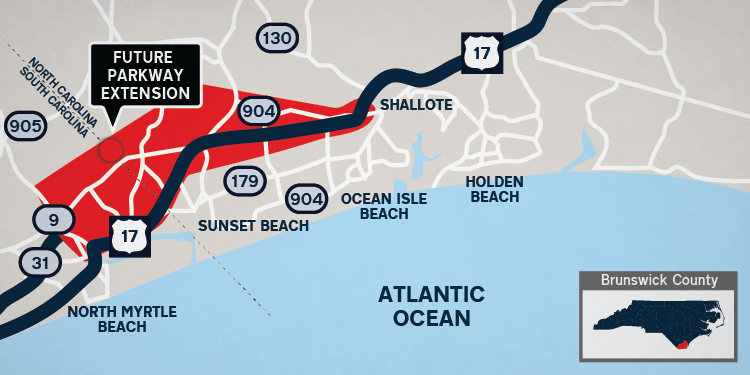 Carolina Bays Parkway project S.C. 31
Carolina Bays Parkway project S.C. 31
Boom or doom: How a new highway could transform rural Brunswick County
A new road in southern Brunswick County will open the flood gates of opportunity for some but could close the doors of homes and businesses for others. The Carolina Bays Parkway Extension project could be the missing link for rural towns to become Brunswick’s next big, booming city. However, some small-town business owners are questioning if the boom will be big enough to reach them. The N.C. Department of Transportation and the S.C. Department of Transportation are working together to extend S.C. 31, known as Carolina Bays Parkway, from S.C. 9 in Horry County, South Carolina, to U.S. 17 in Brunswick County. “The extension would provide a more direct and efficient movement of traffic seeking to bypass congestion within the areas of Calabash in North Carolina as well as Little River and the Grand Strand areas in South Carolina,” per NCDOT’s website. “As a result, local and tourist traffic on area roadways would experience less congestion and delays.” That area includes Brunswick places on each side of U.S. 17: Growing Carolina Shores, Calabash and Sunset Beach at the coast and inland more rural Hickman’s Crossroads, Ash and Longwood. South Carolina is almost ready to begin construction on its end, but North Carolina has yet to find a landing spot as well as funding. With a majority of potential connection spots near Hickman Road and a new shopping center on the way near Carolina Shores, people and businesses in southern Brunswick County could be teetering on trouble or treasure.
Twenty years in the making
The Carolina Bays Parkway Extension project began in 2006 with a feasibility study with conceptual alternative routes and has evolved into seven potential routes being studied. Interactive maps of the alternatives can be viewed on NCDOT’s website. The NCDOT portion of the project is only funded for preliminary engineering, NCDOT spokeswoman Lauren Haviland said, but not for right-of-way, utilities or construction. Right-of-way, utilities and construction for NCDOT’s part of the project is estimated to cost $809,700,000, Haviland said. Shallotte Mayor Walt Eccard has watched and supported the road project for about 10 years. He said it’s a complicated project with multiple agencies involved in both states. “I’m a big supporter of this project, I think it’s critical,” Eccard said. “I think the area will benefit, I think citizens will benefit in their travels.” If constructed, the route will be built in phases and enhance evacuation routes, improve safety and smooth out traffic flow as the county continues to grow in population. Exact costs and timelines to construct each phase for the North Carolina side have not been determined, Haviland said. Despite eagerness, Eccard said NCDOT has no funding to support its portion of the road. “Ultimately, we cannot move forward even when a route is selected until we have adequate funding and that’s been an issue for several years now,” Eccard said. Horry County in 2016 passed a capital projects sales tax referendum that allocated $125 million for its portion of the project, according to NCDOT’s website. In North Carolina, $4.1 million was allocated for planning and design. Public hearings for the North Carolina side of the extension have been delayed several times but, Eccard said, there is hope the draft environmental impact statement will be available this spring so public hearings and review can start, and a final route can be selected by NCDOT. Haviland confirmed a public hearing will be held in late spring if the draft environmental impact statement is approved soon. NCDOT has seven alternative maps for preferred routes in Brunswick County that will eventually dump onto U.S. 17. However, five alternatives cross on the northern side of U.S. 17 around Hickman’s Crossroads along Hickman Road in Calabash.
Impacting generations
Distant relatives David and Myles Bennett were born and raised in the Calabash area. Myles was raised on Thomasboro Road near the heart of Calabash while David was raised on the northern side of U.S. 17 around Hickman’s Crossroads. The Bennetts have been in the Calabash area since the 1800s, Myles Bennett said, noting most know their family through farming and the seafood restaurant business. David Bennett is also related to the Hickman’s, who have lived in the Ash and Longwood areas since the 1700s. He said the property he lives on has been in his family’s name since 1845 and that his father’s entire life was spent on the property. “His life was here. … And he was so worried that if they took that away, then he had to leave here,” he said. One of the alternative routes connecting near Hickman’s Crossroads would place the road on top of David Bennett’s dining and living room and partially through the Manley Bennett Cemetery that holds approximately 300 graves, with some headstones dating back to the 1800s. SCDOT is currently working with NCDOT to secure the environmental permit from the Federal Highway Administration, SCDOT spokeswoman Hannah Robinson said in early January. “Once the document is secured, right-of-way acquisition can begin,” Robinson said. “At this time, we anticipate construction to begin in 2028.”
Needed project with a questionable future
The timeline and future of the project is still unknown. Though project start and completion dates are still in question, local leaders look forward to the additional road and evacuation route. “The county only has one main artery and it impacts the ability for people to move around,” Carolina Shores Mayor Dan Conte said. “The extension would be a boom to Ash, but it would also help us.” The extension is a “critical infrastructure need,” said Conte, because it will give southern Brunswick County residents more opportunity to move throughout the county with less traffic, especially during an evacuation. “There’s no provision right now to easily move people from our town or from the southern part of the county,” he said, noting N.C. 130 quickly floods during heavy rainfall and residents need an alternative route. With proposed and already approved developments near Ash, Calabash and Longwood areas piling up, the road could also declutter future traffic. Myles Bennett echoed Conte’s thoughts, believing the extension would help decongest existing traffic-prone areas. However, his neighbor Hannah Williams Crane fears the road will only make things worse. Crane was also raised on Thomasboro Road and has deep roots to the Calabash area through her mother’s side of the family, who were the Moore’s. She said Hickman’s Crossroads is already “so congested with traffic.” Many drivers who often travel through Hickman’s Crossroads already plan to get stuck, she added.
Local businesses consider the impact
Though the new road means less traffic along currently congested roads, south traveling traffic flow could stop in front of Carolina Shores as popular retail stores like Walmart and Publix build along U.S. 17. Calabash Deli co-owner Sean Grady said the extension could have a positive or negative impact on the Calabash community. Traveling will likely be easier but new shopping centers and fast food chains could take away customers from small businesses. Existing traffic jams and recent closure of the Calabash Bridge have already deterred potential customers from visiting the small town, he said. “A lot of people are avoiding Calabash because it’s a small, quaint town and some people don’t want to get caught up in the traffic and they kind of stick to the major highway and drive right past us,” Grady said. Like Grady, Coffee Cottage and Calabash Garden Tea Room owner Kathy Cody said it is hard to say the exact impacts the extension will have on the Calabash community since there is no finalized plan nor promised timeline. “The longer it takes them to actually initiate it and make it happen, the harder it’s going to be, and the more people and neighborhoods are going to be affected,” she said.
New road, high housing market, low rural life
Some major housing and commercial developments have already been approved around the potential route area, like the 2,950-home development named Ashton Farms. Housing developments are coming in while rural lifestyles are being pushed out. Myles Bennett and Crane explained they have already seen changes to Calabash as nearby wooded areas are cleared for new housing developments and vehicular traffic increases. “The stuff in front of us has been woods my entire life and just last year we saw them start clearing trees right across the road from Thomasboro,” said Crane, noting they are expected to have over 1,000 new neighbors. The heart of Calabash was built with family-owned businesses. Calabash would have to add more grocery stores and “convenient” businesses if the extension were to push more people to Calabash, Crane said. The “small town feel,” she noted, could be negatively changed. Like Calabash, the Ash and Longwood communities are full of generational families and homes, Crane and David Bennett said. “My grandfather loved this place, and he used to say that J.D. Rockefeller did not have enough money to buy his place,” David Bennett said. Some fear the new road, if built near Hickman’s Crossroads or Ash, will drain the history and culture of the Ash community. “It’s no longer going to be family land, it’s no longer going to be the quiet town that we know,” Crane said. David Bennett’s mother was from Longwood. He said the Longwood community was named after his great grandfather, noting he has relatives that will also be uprooted. The road could cause David Bennett and many others to pack up their lives with nowhere else to go. “I don’t want to go anywhere, I want to stay here, this is my home. … I don’t think people think about the lives that something like that is going to affect,” said David Bennett, noting many local generational families would not survive if they were displaced and forced to live elsewhere. Ocean Isle Beach Mayor and real estate agent Debbie Smith said road projects “typically” have a positive impact on property values, noting homes closer to the new road could increase in value. “Then again, it may change some of the uses from rural farming to more urban development,” Smith said. She said the road will be beneficial to the whole area and “critical for the future of our area” since it will increase access and emergency evacuation routes throughout the county and across state lines. “I think more than anything it would improve transportation and maybe keep some of our roads from becoming overburdened. … It is desperately needed for the area,” Smith said.
Where to grow from here
Brunswick County is seeing tremendous growth and municipalities are planning projects, setting budgets and updating unified development ordinances to prepare for more. “Until we see the final plans, it’s really hard to say,” Eccard said of the extension bringing more traffic to Shallotte. Conte said Carolina Shores is almost completely built out with no room for more major developments. Though the town has no more room, he said traffic will always be an issue. Families living along the alternative routes are conflicted, depressed and worried because they do not know what to do, David Bennett said. For example, he said, upgrading his house could be a waste of time if the home is destroyed in a few years. “It’s constantly in the back of your mind. …. Where are we supposed to go? What are we supposed to do?,” he said. Potential impacts to noise, low income and disadvantaged populations, cultural resources and the environment are considered when selecting the least environmentally damaging and practicable alternative route, Haviland said. “In cases where impacts to private properties are unavoidable, NCDOT will work with individual property owners to help minimize impacts or mitigate through appropriate compensation,” Haviland said. The NCDOT representative said it should have a recommended alternative route selected after the public has time to review the draft environmental impact statement, look at preliminary designs and make formal public comments. “As part of the alternative analysis process, impacts to communities, properties, landowners and businesses are considered. … Comments from the public are always welcomed and encouraged. The formal comment period will take place once the public hearing has been scheduled,” Haviland said.
Read more » click here
Previously reported – November 2023
Carolina Bays Parkway project S.C. 31
As many of you know the extension of Carolina Bays 31 from SC to NC has been an ongoing project for many years that has been accelerated by the fact that SC has the funding and the desire to complete the existing SC31 to the NC state line. This has caused NC to produce a plan even though they have no funding for the road to enter NC and go north towards Wilmington.
There have been numerous rumors about what routes are and are not being considering and quite honestly there are some things that we do know for fact after the most recent meeting but there are even more things that we, and NCDOT for that matter, don’t have answers to at this point. The purpose of this communication is to make everyone aware of what we know. At the Sept Board meeting the Community Impact Committee made a presentation that clearly identified 2 of the proposed routes along with many of the details surrounding a project like this. It is suggested that if you haven’t seen it to review the below “Enumerate Engage – Login” link for more detail about this project.
What we know based on the last meeting with the NCDOT two weeks ago;
- SC has the funding thru a sales tax in Horry County
- SC has asked NC where to end their construction to the NC SC state line or in other words, where does NC want the SC portion to end?
- NC has selected route 4 which is east of Indigo Farms near Hickman Road (NC 57)
- Carolina Bays is a high priority for the BC county region of NCDOT but there is NO funding for this project, and it will have to compete with other projects throughout NC based on a set of criteria which at this point has placed it as a low priority within NC.
- NCDOT has decided to have a 3 Phase plan for the road in NC.
- Phase 1 will take SC31 from the state line to a new interchange at Ash Little River Road
- Phase 2 will take it from there to Longwood Road NW (Rte. 904) near the Grissettown Longwood Fire and Rescue Department.
- Phase 3 will take it from there to Route 17 at either the Rte. 904 or the Rte. 130 intersection
- The Environmental Impact Study (EIS) although not officially approved is close to approval and once it is approved there will be 2 public meetings (one in NC & one in SC) to solicit input on the 2 alternative routes to connect to 17. These meetings will take place sometime in mid to late Q1 ’24
- At this point only Phase 1 & 2 are locked in with preliminary funding expected in 2025 or 2026
- Phase 3 is still under review. No route has been selected albeit there is solid rationale for both alternatives and a route must be selected prior to any State or Federal funding proposals that are to be are submitted.
- The public meetings will be VERY important in determining the Phase 3 route !!!
Without funding, NCDOT continues Carolina Bays Parkway discussion
On Oct. 16, the Grand Strand Area Transportation Study (GSATS) Transportation Advisory Committee (TAC) and the GSATS Policy Committee with both North Carolina and South Carolina participants met. Both meetings were held at Ocean Isle Beach Town Hall. Both meetings were open to the public and focused on the Carolina Bays Parkway Extension project that will extend Carolina Bays Parkway — also known as South Carolina Highway 31 — from South Carolina Highway 9 in Horry County, South Carolina, across the North Carolina state line to US Highway 17 in Brunswick County. Representatives from participating towns, cities and counties and project leads from the North Carolina Department of Transportation (NCDOT) were in attendance. During the combined policy meeting, participants received a presentation by NCDOT Division 3 Engineer Chad Kimes and Project Development and Environment Analysis (PDEA) Engineer Mason Herndon. Kimes told the committee that NCDOT wants to start obtaining funding for the extension by the end of next year to get the North Carolina side of the project moving. “I can tell you, Carolina Bays is one of our number one priorities in this region that’s unfunded, currently, by the state of North Carolina,” he said. Kimes explained that they are going to try several ways to get state funding over the next few months and they will know a little more by spring 2024. He noted that the project had been submitted for state funding in the past, however, they have yet to receive any money. “The lowest project to score in our scoring system that got picked up in our [Transportation Improvement Plan (TIP)] program scored a 74.6,” he said. “We were scoring the Carolina Bays at a 62.71. The difference between that 62 and that 74.6 is about $14 billion worth of projects in between, so there was a big difference…” He told the board that NCODT will be applying for federal grants too, however, all grants will require a match by the state. “On a price tag like this, North Carolina can match anywhere between 30 and 50% on federal grants but we will be pursuing it,” Kimes said. If they do apply for federal grants, the project may score better in the prioritization process because it will bring down the overall cost of the project for North Carolina. Kimes noted they are looking to lower project costs by eliminating interchanges and installing superstreets, adding they may reduce the number of right a ways, too, and that things can be changed in the future. Kimes said they are seeking to connect the project to US Highway 17 sooner to lower overall costs and are still considering installing tolls along the project to offset the total cost as well. Herndon gave the Policy Committee, along with a good-sized audience, a presentation on NCDOT’s progress on the project, funding and planning. Herndon said they are studying seven different routes in the draft Environmental Impact Statement (EIS), however, alternative route four is the preferred one at the moment. He explained that one of the interchanges would go up to Ash Little River Road in Ash. Alternative four would connect with South Carolina at Hickman Road Northwest in Calabash, and travel through Hickman’s Crossroads. It would cross the Hickman’s Branch River and the Cawcaw Swamp. The suggested route would take the project to Gwynn Road Northwest in Longwood and Bland Road Northwest in Longwood. If alternative map four is chosen for the extension, the project would not connect with US Highway 17 until its intersection with Longwood Road and Seaside Road near Grissettown. “Alternative four ties into [US Highway] 17 at the 904 intersection,” Herndon said. Asked how much money had been committed on North Carolina’s end, Herndon said none. He said they were told by the Federal Highway Administration (FHA) to look at an “affordable solution” to get the project started since they have no funding currently. He said NCDOT has been working on it and has sent the draft EIS, which includes all seven alternatives, to the FHA. He said NCDOT will eventually have a financial plan to show their commitment to the entire project with South Carolina. Herndon said the project would be done in phases — phase one would either stop at the North Carolina and South Carolina boarder or carry into Brunswick County up to Ash Little River Road. “Now, we’re not talking about this as the complete project, this is just phase one of the project,” he said. “Every project that we’ve got is so many miles long that we build it in sections, and it has to have logical termini. So, basically, those are the two logical termini we feel like we can start with.” If phase one were carried into Brunswick County, he said an interchange would be built at Ash Little River Road. “This would require us to do improvements along Hickman Road and along Ash Little River Road to get traffic to 904 until phase two is built,” he said. A timeline for phase one could not be provided at this time. “Until we actually have money in the bank for this project in North Carolina… that’s going to be when we can really develop a timeline,” Herndon said. He said they hope that having this plan, with some committed funds, will help move things forward, and also explained that the final EIS may not get approved without a full financial plan for the entire project. Kimes said he felt confident that they will receive right of way funding by the end of 2024 to kickstart the project. With the project plan coming together, Herndon said he expects public hearings to commence in early 2024. Shallotte Mayor Walt Eccard said he has been telling folks for three years that there would be a meeting to discuss the draft EIS. He asked how sure they were about the public hearings and if early 2024 was a reasonable date to tell people. In response, Herndon said he felt fairly confident that there would be public meetings for the extension, and they could begin in early 2024. He noted that the final EIS meeting might not be until the end of 2024 or beginning of 2025. “The public hearings after the draft EIS [are] to give public input on what we’re proposing,” Herndon said. He explained the final EIS would contain the final determined route for the Carolina Bay Parkway Extension, however, the drafted EIS, used for information purposes, will include all seven alternative routes. Brunswick County Board of Commissioners Chair Randy Thompson said there would be major construction work that would take years if alternative four is chosen. He said he was concerned about the potential traffic on affected roads during the duration of the project’s construction, noting that traffic is already a major issue with the county’s increasing population growth. “We need the highway; there’s no doubt about that. We need the highway,” Thompson said. Kimes said they will look at all the potentially effected roads to see what they can handle and make sure steps are in place for potentially needed improvements. All of the alternative routes can be found online on the NCDOT website at https://www.ncdot.gov/projects/carolina-bays-parkway/Pages/project-maps.aspx
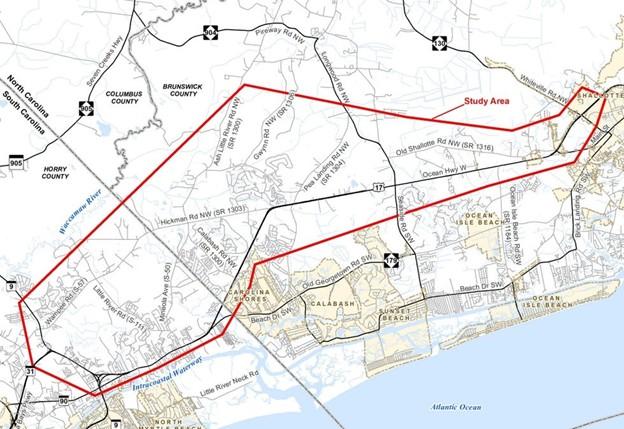
Corrections & Amplifications –

Island Homes Sold – 2024 * Lou’s Views
A complete list of homes sold in 2024
Island Land Sold – 2024 * Lou’s Views
A complete list of land sold in 2024
Island Properties Sold – Comparison * Lou’s Views
A comparison of Holden Beach properties sold through the last three (3) years
Odds & Ends –
 Brunswick Community College holds groundbreaking for new first responder training center
Brunswick Community College holds groundbreaking for new first responder training center
Brunswick Community College held a groundbreaking ceremony Friday morning for the new “Alan Holden Public Safety Center,” named after the chair of BCC’s Board of Trustees. The building will be located directly behind the main entrance to the college off highway 17. Construction of the more than 28,000 square-foot facility is scheduled to begin Monday. The state-of-the-art facility will feature a wide array of specialized labs and training rooms. Including a moveable wall tactical firearm room, a self-defense arrest techniques mat room, fire truck and police scenario simulators, and EMS scenario training rooms. College president Gene Smith says the new facility will continue BCC’s mission of expanding with the community. “This facility will provide the opportunity for BCC to continue to serve our students and meet the needs of our community for many, many, many, years to come,” Smith stated. Construction is estimated to finish in March of 2026.
Read more » click here
BCC breaks ground on Alan Holden Public Safety Center
Brunswick Community College (BCC) on Jan. 31 celebrated the groundbreaking of the Alan Holden Public Safety Center today, marking the beginning of a transformative project that will bolster educational and career opportunities while addressing critical workforce needs in the region. Construction of the 28,278-square-foot facility is scheduled to begin on Feb. 3, with an estimated completion date of March 2026. The state-of-the-art facility will feature a wide array of specialized labs and training rooms, including a VirTra Simulator, moveable wall tactical firearm room, self-defense/arrest techniques mat room, driving simulators, EMS scenario training rooms, and an apparatus bay. It will serve as the new home for numerous programs and certifications designed to train the next generation of public safety professionals. “Today’s groundbreaking is a monumental step forward in Brunswick Community College’s mission to meet the growing needs of our community,” said Dr. Gene Smith, President of BCC. “The Alan Holden Public Safety Center will provide top-tier education and training opportunities for students and support in-service training for our local law enforcement officers, fire, and rescue personnel. We are deeply honored by Alan Holden’s generosity and his trust in BCC to carry forward a legacy of excellence and service to our community.” The facility will house Associate in Applied Science degree programs in Criminal Justice Technology, Emergency Medical Science (EMS), and Public Safety Administration with specializations in Corrections, Law Enforcement, and Emergency and Fire Management, and 911 Communication and Operations. In addition, the center will offer diploma, certification, and continuing education courses such as Basic Law Enforcement Training (BLET), Emergency Medical Responder (EMR), Advanced Life Support (ALS), and a variety of firefighter training programs. “This project is a game changer for the safety and well-being of the people of Brunswick County and beyond,” said Sheriff Brian Chism. “The Alan Holden Public Safety Center will provide invaluable training resources for public safety professionals, ensuring they are prepared to protect and serve at the highest level. We are grateful to both Mr. Holden and BCC for their continued contributions to and support of our community.” For more information about Brunswick Community College and the Alan Holden Public Safety Center, visit brunswickcc.edu.
Read more » click here

Alerts
Brunswick County uses ReadyBrunswick as part of the County’s effort to continuously improve communications during emergency situations within our area. Powered by Everbridge, the ReadyBrunswick notification system sends emergency notifications in a variety of communication methods such as:
- Landline (Voice)
- VoIP (Voice over Internet Protocol)
- Mobile (Voice)
- Mobile SMS (Text Messaging)
In the case of an emergency, you may choose to receive notifications via one or all of these communication methods. It’s recommended that you register several media options to receive messages in the event a particular communication device is unavailable.
For more information » click here
Brunswick County Emergency Communications Notification System
Get notified about emergencies and other important community news by signing up for our ReadyBrunswick Emergency Notification System. This system enables us to provide you with critical information quickly in a variety of situations, such as severe weather, unexpected road closures, missing persons, evacuations of buildings or neighborhoods, and more. You will receive time-sensitive messages wherever you specify, such as your home, mobile or business phones, email address, text messages and more. You pick where, you pick how.
SIGN UP HERE to choose the type of alerts you want to receive
This and That –
Car insurance companies ask for 22.6% rate increase in North Carolina
Companies asked for proposed rate hike to take effect Oct. 1
Auto insurance companies are asking for a sizable rate increase in North Carolina, up an average of 22.6%. The request for the rate increase was filed by the North Carolina Rate Bureau on Monday, Feb. 3, the state Department of Insurance said. The companies asked that their proposed insurance rate hike take effect Oct. 1. Now that the request has been filed, the insurance commissioner has 60 days to review it, according to the department. During his review, Commissioner Mike Causey will determine if the companies’ request is justified. If he disagrees with their request, Causey has the power to have the Department of Insurance negotiate a settlement, or he can call for a hearing. State officials said settlements have been reached in the past, but if the companies’ request goes to a hearing, a hearing officer would have the final say. Monday’s filing comes two years after the companies asked for a 28.4% increase. That request eventually resulted in a settlement with an average 4.5% increase per year for two years. In a statement, N.C. Rate Bureau COO Jarred Chappell said the request for an increase comes as vehicles and repairs have become more expensive and accidents have become more common. “This request reflects the fact that vehicles and repairs are getting more expensive, partly because automakers pack so much technology into modern vehicles,” Chappell said. “Accidents have become more common, partly because distracted driving has eroded driving habits. Vehicle weights are up, and so is horsepower, both of which make accidents more severe.” Chappell said North Carolina has some of the lowest auto insurance rates in the country, and said an increase is needed to “ensure a large number of companies want to write policies in the state.”
Read more » click here
When will the Brunswick County Visitors Center re-open?
The Brunswick County Visitors Center, a state-operated facility in Shallotte, is a popular rest stop for those driving along U.S. 17. Located at the intersection of U.S. 17 and N.C. 130 between Wilmington and Myrtle Beach, the facility is a North Carolina Department of Transportation rest area that serves thousands of patrons each year. But the facility has been closed for renovations and has not yet re-opened. A reader recently wrote to the StarNews and inquired about plans to re-open the facility. Here’s what we found out.
When did the facility close?
The visitors center closed in fall 2023 for construction.
What did the project include?
According to a previous StarNews article, the project involved several improvements, including a new family restroom facility, water line, updated drainage and landscaping improvements. The article stated a construction contract for $981,000 was awarded to Kowen General Contractors out of Maxton for the project.
What was the project timeline?
Kowen was able to begin construction in October 2023, but according to Lauren Haviland, spokeswoman for the NCDOT, the firm did not start groundwork until March 2024. “That delay was due to the contractor had never done work for NCDOT before and was unfamiliar with the processes, such as working with certified sub-contractors,” Haviland said, in an email. “Also, several items of work have been added, extending their agreement to the end of the year.”
What items were added to the project?
Haviland said additional work includes waterline and hydrant installation, additional tile work, removing and replacing existing sidewalks, additional support at one of the entrances, cabinet work in one of the rooms, and removing and replacing the fascia. Haviland noted that while the original contract amount was $981,000, the project was funded for $1.5 million. As of the November 2024 estimate, Haviland said NCDOT had spent about $1,352,000.
When will it be completed?
According to Haviland, construction is expected to be completed in late January 2025.
Read more » click here
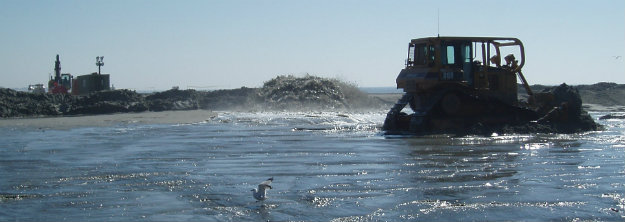 Why rising costs have left some Wilmington-area beach nourishment projects high and dry
Why rising costs have left some Wilmington-area beach nourishment projects high and dry
Carolina and Kure beaches in New Hanover County and Oak Island in Brunswick County could be left waiting for sand due to rising dredging costs and a surge in demand for such projects nationwide
Some Wilmington-area beaches, recently covered by a rare snow storm, will soon again be a hive of activity as officials take advantage of the open environmental window − outside of sea turtle and shorebird nesting season − to pump fresh sand onto the vital economic engines for many coastal communities. The activity, however, will be muted this year, and that has officials in both New Hanover and Brunswick counties concerned.
What’s going on?
Call it the law of supply and demand. Beach nourishment is inherently expensive, requiring lots of pre-project planning and permit work and then securing an acceptable sand source that can be pumped onto a beach. If that borrow site is farther away than say a nearby inlet, like Wrightsville Beach and Carolina Beach mine for their projects, it will cost more to move the sand from the source to the beach. “Sources of sand are drying up in some places,” said Dr. Robert Young, director of the Program for the Study of Developed Shorelines at Western Carolina University. “Borrow areas don’t make sand. These are non-renewable resources. And as you creep offshore even a little, costs go up, often a lot. But another factor that’s helping send the cost of beach nourishment surging is the high demand for projects to rebuild beaches all along the Gulf and East coasts battered by recent hurricanes and the few number of American companies out there in the dredging business. “There are simply a limited number of companies out there that can do this kind of work, and competition is fierce because we’re literally trying to hold the line everywhere from Saco, Maine, to Padre Island, Texas, and that’s only a little bit of an exaggeration,” Young said. “When you have a lot of demand and not a ton of supply, the people who do work like this are really in the driver’s seat.”
What have been the impacts this year?
With prices coming in well above predictions, some Cape Fear-area beach towns are having to adapt and make painful decisions. In New Hanover County, the periodic federal nourishment of Carolina and Kure beaches is one that has fallen victim to the financial headwinds. The Pleasure Island project had an estimated cost of just under $20 million. But the only bid for the work the Army Corps of Engineers received came in at $37.5 million. In a letter to residents, Kure Beach Mayor Allen Oliver said the price differential was just too much to overcome this winter. “Getting additional bidders are slim and since the price was double the estimated project cost, the best possible solution is to postpone the event until next year,” the mayor said. “We should get better pricing and more bidders participating.” The delay means the two New Hanover beach towns will have to go longer than expected without a fresh injection of sand − a worry for officials and residents in a world where climate change is increasingly fueling stronger and bigger tropical storm systems. “This is not the most favorable situation for us and Carolina Beach, but honestly it is the most logical decision based on the lack of bidders and the cost of the single bid received,” Oliver said. In Brunswick County, Oak Island also is feeling the pain of higher prices and not enough competition. When the town opened bids up this fall for a large-scale, end-to-end beach nourishment project to take place this winter, the bids from two companies “were significantly above a feasible budget for the town, which was reflective of the fact that there is essentially no availability of dredging company equipment to conduct the project during that timeframe,” states a post on Oak Island’s website. The project is estimated to cost at least $40 million, with half of that covered by a one-time state grant. Bids for the same work to take place during the 2025-26 dredging window came closer to the town’s budget, and Oak Island officials are now in negotiations to see if the work can get done between mid-November and late April 2026. “If negotiations are not successful, the project will be rebid in 2025,” the town stated online. Now officials and residents have to hope the beach can hold out until then. Hurricane Isaias, which raked the Brunswick County shoreline nearly five years ago, chewed away a lot of the beach. Storms, king tides and gradual sea-level rise has since then added to the pain − not to mention the no-name storm and the remnants of Tropical Storm Helene that hit Brunswick County last September and October, respectively. Big beach projects aren’t the only ones getting caught up in the financial squeeze. A project put out to bid by the corps of engineers to dredge the shipping channel near the mouth of the Cape Fear River this winter and place the sand on Oak Island and Caswell Beach also came in 20% over estimates.
Is it all bad news?
At least one beach town in the Wilmington area will be seeing new sand this winter. This week, Surf City will begin pumping sand from Banks Channel on the Intracoastal Waterway side of the Pender County beach town onto its beach strand. The nearly $20 million project, which is expected to wrap up in late March, will nourish the town’s entire strand, adding an estimated 60 feet of beach from the Topsail Beach line to 1,000 feet north of the Surf City Fishing Pier. Town Manager Kyle Breuer said although Surf City only received one bid for the work, it was within the town’s estimates and the timing of when the dredging could take place within the fairly narrow fall/winter navigational window also worked. “We were very fortunate and very thankful,” he said. Breuer noted that not only will the project help nourish Surf City’s eroded beach but also piggyback on the earlier dredging of parts of Banks Channel done by Topsail Beach to improve navigation around the southern half of Topsail Island. The breakdown of the project’s cost is roughly $5 million from Surf City and about $14.5 million in funding coming through a one-time state grant.
What does the future look like?
Unfortunately, a lot like today − if not worse − for beach towns desperate to hold back the encroaching ocean, Western Carolina’s Young said. He said the pressures that are driving prices upward are only likely to increase as sea-level rise, more storms and increased development make shore protection efforts more frequent and necessary than ever along many parts of the country’s oceanfront. The new Trump administration’s stated goal of taking a fine-tooth comb to the federal budget and slashing a lot of discretionary spending also could leave many coastal communities hunting for new revenue sources outside of Washington just as dredging prices surge and the need for beach nourishment increases. “Beaches are not stable, they move, so the only future I see is one where costs are increasing because there’s only so much sand and we’re doing it more often and in more places,” Young said.
Read more » click here
Fauna & Flora –

NC State Native Plant Resources » click here
NC Sea Grant Coastal Landscapes » click here
New Hanover County Arboretum Native Plant Garden » click here
Audubon Native Plant Database » click here
Fauna & Flora » click here
Holden Beach recommended plant list – deer resistant & salt tolerant
Factoid That May Interest Only Me –
 People flocked to this North Carolina city in 2024.
People flocked to this North Carolina city in 2024.
Now, it ranks No. 1 in US — again
North Carolina is home to the nation’s hottest place for people to start calling home — again, a new report finds. Wilmington ranks No. 1 on a list of metropolitan areas that attracted new residents in 2024, according to data the moving company United Van Lines shared with McClatchy News on Jan. 2. The city, near popular beach destinations, wasn’t the only North Carolina-based metro to receive recognition. The Charlotte, Raleigh and Hickory areas also ranked among the top places people flocked to last year, according to moving companies. Wilmington topped its list after United Van Lines said it studied thousands of moves in metro areas across 48 states and Washington, D.C. It studied the percentage of people moving into and out of each place to determine where they settled down.
What makes Wilmington rank No. 1?
When compared to all metro areas across the country, Wilmington reigned supreme with 83% of inbound moves compared to 17% outbound, results show. The Wilmington area regained the top spot that it held in the 2022 rankings, when United Van Lines praised the area for its “large historic district, vibrant riverfront” and proximity to the coast. The metro had slipped to the No. 2 spot on the 2023 list, McClatchy News reported. The latest results were published as U-Haul shared similar lists in early January. The moving company in a news release said it studied “net gains of U-Haul customers taking one-way equipment into and out of metro areas” in 2024. On both the U-Haul and United Van Lines lists, North Carolina ranked among the top 10 states gaining new people. “While U-Haul rankings may not correlate directly to population or economic growth, the U-Haul Growth Index is an effective gauge of how well states, metros and cities are attracting and maintaining residents,” the company wrote. Here’s how other North Carolina-based metros fared in the national rankings: Hickory at No. 9 for all metros (United Van Lines) Charlotte at No. 1 and Raleigh at No. 8 for larger metros (United Van Lines) Charlotte at No. 2 and Raleigh at No. 7 for all metros (U-Haul) After Wilmington, these metros rounded out the nation’s top five favorite places to move, per United Van Lines: Springfield, Missouri, at No. 2 Myrtle Beach, South Carolina, at No. 3 Flagstaff, Arizona, at No. 4 Brownsville-Harlingen, Texas, at No. 5
Read more » click here
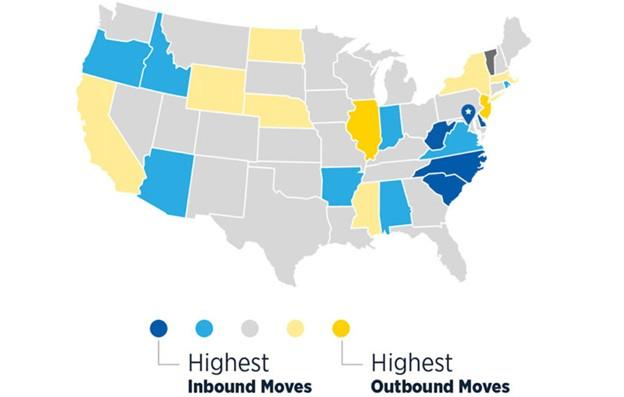
Study: Wilmington area No. 1 place people are moving to
A national moving company that releases data on where people are entering and exiting annually has put out its 2024 study.
It rates Wilmington, North Carolina, among the top metropolitan statistical area people are moving to, according to United Van Lines. The company has traced migration patterns on a state-by-state basis since 1972 and utilized data from its parent company, UniGroup, handling household moves in 48 states and D.C. Wilmington MSA consists of the tri-county region (New Hanover, Brunswick and Pender counties) and has come in the top 10 for many years now but climbed to the number-one slot in 2022 as well. The 2024 study indicates that 83% of people the company tracked moved to the Wilmington MSA, with 17% leaving in 2024. Only two other North Carolina cities came in the top 25, including Greenville (74% inbound and 26% outbound) and Greensboro-Winston-Salem area (65% inbound and 35% outbound). Located 77 miles south of Wilmington, the area of Myrtle Beach, South Carolina, tracked number three (80% inbound and 20% outbound). Overall, North Carolina was the number five state people moved to, according to the survey, with South Carolina topping out at number three. The company asks surveyors if they are moving due to improved cost of living, to be closer to family, for retirement, as a company transfer or for a new job, or for a lifestyle change. North Carolina came in number seven for people to move for retirement. Neighboring South Carolina came in third for retirement, fifth for lifestyle change and sixth for improved cost of living. West Virginia jumped nine spots since 2023 and came in as the number one state people flocked to, due to its affordable housing, outdoor activities, and the cost of living being lower than the national average. For the seventh year in a row, New Jersey has remained the most highly exited state, with most movers leaving due to retirement. “As housing costs continue to rise, Americans are moving to lower density, more affordable regions between expensive, economic-driving states,” an economist and professor in the department of public policy at the UCLA, Michael Stroll, noted in the release. See United Van Lines full report here.
Read more » click here
Hot Button Issues –
Subjects that are important to people and about which they have strong opinions

Climate
For more information » click here.
There’s something happening here
What it is ain’t exactly clear
2024 Brought the World to a Dangerous Warming Threshold. Now What?
Global temperatures last year crept past a key goal, raising questions about how much nations can stop the planet from heating up further.
At the stroke of midnight on Dec. 31, Earth finished up its hottest year in recorded history, scientists said on Friday. The previous hottest year was 2023. And the next one will be upon us before long: By continuing to burn huge amounts of coal, oil and gas, humankind has all but guaranteed it. The planet’s record-high average temperature last year reflected the weekslong, 104-degree-Fahrenheit spring heat waves that shuttered schools in Bangladesh and India. It reflected the effects of the bathtub-warm ocean waters that supercharged hurricanes in the Gulf of Mexico and cyclones in the Philippines. And it reflected the roasting summer and fall conditions that primed Los Angeles this week for the most destructive wildfires in its history. “We are facing a very new climate and new challenges, challenges that our society is not prepared for,” said Carlo Buontempo, director of the Copernicus Climate Change Service, the European Union monitoring agency. But even within this progression of warmer years and ever-intensifying risks to homes, communities and the environment, 2024 stood out in another unwelcome way. According to Copernicus, it was the first year in which global temperatures averaged more than 1.5 degrees Celsius, or 2.7 degrees Fahrenheit, above those the planet experienced at the start of the industrial age. For the past decade, the world has sought to avoid crossing this dangerous threshold. Nations enshrined the goal in the 2015 Paris agreement to fight climate change. “Keep 1.5 alive” was the mantra at United Nations summits. Yet here we are. Global temperatures will fluctuate somewhat, as they always do, which is why scientists often look at warming averaged over longer periods, not just a single year. But even by that standard, staying below 1.5 degrees looks increasingly unattainable, according to researchers who have run the numbers. Globally, despite hundreds of billions of dollars invested in clean-energy technologies, carbon dioxide emissions hit a record in 2024 and show no signs of dropping. One recent study published in the journal Nature concluded that the absolute best humanity can now hope for is around 1.6 degrees of warming. To achieve it, nations would need to start slashing emissions at a pace that would strain political, social and economic feasibility. “It was guaranteed we’d get to this point where the gap between reality and the trajectory we needed for 1.5 degrees was so big it was ridiculous,” said David Victor, a professor of public policy at the University of California, San Diego. The question now is what, if anything, should replace 1.5 as a lodestar for nations’ climate aspirations. “These top-level goals are at best a compass,” Dr. Victor said. “They’re a reminder that if we don’t do more, we’re in for significant climate impacts.” The 1.5-degree threshold was never the difference between safety and ruin, between hope and despair. It was a number negotiated by governments trying to answer a big question: What’s the highest global temperature increase — and the associated level of dangers, whether heat waves or wildfires or melting glaciers — that our societies should strive to avoid? The result, as codified in the Paris agreement, was that nations would aspire to hold warming to “well below” 2 degrees Celsius while “pursuing efforts” to limit it to 1.5 degrees. Even at the time, some experts called the latter goal unrealistic, because it required such deep and rapid emissions cuts. Still, the United States, the European Union and other governments adopted it as a guidepost for climate policy. Christoph Bertram, an associate research professor at the University of Maryland’s Center for Global Sustainability, said the urgency of the 1.5 target spurred companies of all kinds — automakers, cement manufacturers, electric utilities — to start thinking hard about what it would mean to zero out their emissions by midcentury. “I do think that has led to some serious action,” Dr. Bertram said. But the high aspiration of the 1.5 target also exposed deep fault lines among nations. China and India never backed the goal, since it required them to curb their use of coal, gas and oil at a pace they said would hamstring their development. Rich countries that were struggling to cut their own emissions began choking off funding in the developing world for fossil-fuel projects that were economically beneficial. Some low-income countries felt it was deeply unfair to ask them to sacrifice for the climate given that it was wealthy nations — and not them — that had produced most of the greenhouse gases now warming the world. “The 1.5-degree target has created a lot of tension between rich and poor countries,” said Vijaya Ramachandran, director for energy and development at the Breakthrough Institute, an environmental research organization. Costa Samaras, an environmental-engineering professor at Carnegie Mellon University, compared the warming goals to health officials’ guidelines on, say, cholesterol. “We don’t set health targets on what’s realistic or what’s possible,” Dr. Samaras said. “We say, ‘This is what’s good for you. This is how you’re going to not get sick.’’ “If we were going to say, ‘Well, 1.5 is likely out of the question, let’s put it to 1.75,’ it gives people a false sense of assurance that 1.5 was not that important,” said Dr. Samaras, who helped shape U.S. climate policy from 2021 to 2024 in the White House Office of Science and Technology Policy. “It’s hugely important.” Scientists convened by the United Nations have concluded that restricting warming to 1.5 degrees instead of 2 would spare tens of millions of people from being exposed to life-threatening heat waves, water shortages and coastal flooding. It might mean the difference between a world that has coral reefs and Arctic sea ice in the summer, and one that doesn’t. Each tiny increment of additional warming, whether it’s 1.6 degrees versus 1.5, or 1.7 versus 1.6, increases the risks. “Even if the world overshoots 1.5 degrees, and the chances of this happening are increasing every day, we must keep striving” to bring emissions to zero as soon as possible, said Inger Anderson, the executive director of the United Nations Environment Program. Officially, the sun has not yet set on the 1.5 target. The Paris agreement remains in force, even as President-elect Donald J. Trump vows to withdraw the United States from it for a second time. At U.N. climate negotiations, talk of 1.5 has become more muted compared with years past. But it has hardly gone away. “With appropriate measures, 1.5 Celsius is still achievable,” Cedric Schuster, the minister of natural resources and environment for the Pacific island nation of Samoa, said at last year’s summit in Azerbaijan. Countries should “rise to the occasion with new, highly ambitious” policies, he said. To Dr. Victor of U.C. San Diego, it is strange but all too predictable that governments keep speaking this way about what appears to be an unachievable aim. “No major political leader who wants to be taken seriously on climate wants to stick their neck out and say, ‘1.5 degrees isn’t feasible. Let’s talk about more realistic goals,’” he said. Still, the world will eventually need to have that discussion, Dr. Victor said. And it’s unclear how it will go. “It could be constructive, where we start asking, ‘How much warming are we really in for? And how do we deal with that?’” he said. “Or it could look very toxic, with a bunch of political finger pointing.”
Read more » click here
2024 was the hottest year on record, breaching a critical climate goal and capping 10 years of unprecedented heat
It’s official: 2024 was the hottest year on record, breaking the previous record set in 2023 and pushing the world over a critical climate threshold, according to new data from Europe’s climate monitoring agency Copernicus. Last year was 1.6 degrees hotter than the period before humans began burning large amounts of fossil fuels, Copernicus found. It makes 2024 the first calendar year to breach the 1.5-degree limit countries agreed to avoid under the Paris climate agreement in 2015. Scientists are much more concerned about breaches over decades, rather than single years — as above that threshold humans and ecosystems may struggle to adapt — but 2024’s record “does mean we’re getting dangerously close,” said Joeri Rogelj, a climate professor at Imperial College London. The Copernicus analysis points to a slew of climate records falling last year: The planet endured its hottest day on record in July; each month from January to June was the warmest such month on record; and levels of planet-heating pollution reached unprecedented highs. Last year is part of a pattern of off-the-charts heat. Every single one of the world’s 10 hottest years happened in the last decade, according to Copernicus data. Behind these statistics lies a huge toll. “Every fraction of a degree … brings more harm to people and ecosystems,” Rogelj said. The extreme weather that swept the globe last year shows just how dangerous life in a warmer world already is. Back-to-back hurricanes in the US, fueled by ultra-warm ocean temperatures, killed hundreds of people. In Spain, more than 200 people died in catastrophic floods. Amazon rivers fell to unprecedented lows during the region’s worst drought on record and the Philippines experienced an extraordinary typhoon season, with six in just 30 days. The climate crisis played a role in all of these extreme events, according to scientific analyses. Scientists are still trying to fully understand why global heat has been so extreme for the past two years. The main driver is clear: the human-caused climate crisis, boosted by El Niño, a natural climate pattern that tends to have a warming influence, which began in 2023 and ended earlier this year. But it doesn’t explain all of the heat. Scientists have also pointed to a recent drop in shipping pollution following regulations — a win for human health, but, in a cruel twist, this type of pollution also helps cool the planet by reflecting sunlight back into space. The eruption of a huge underwater volcano in the South Pacific in 2022, which sent plumes of water vapor — a potent greenhouse gas — into the atmosphere may have also contributed. Then there are the clouds. A December study found a dearth of sun-reflecting clouds over the ocean may be another factor. Scientists believe it’s unlikely 2025 will be another record-breaking year. La Niña, a natural climate pattern that tends to have a global cooling influence, was declared Thursday. “But people shouldn’t think that’s climate change hitting pause or plateauing,” said Paulo Ceppi, a climate scientist at Imperial College London. “A small dip doesn’t change the clear upward trajectory we’re on,” he added. Scientists say the decades to come are likely to be hotter still as humans continue to burn planet-heating coal, oil and gas. “The world doesn’t need to come up with a magical solution to stop things from getting worse in 2025,” said Friederike Otto, a climate scientist at Imperial College London. ‘We know exactly what we need to do to transition away from fossil fuels.”
Read more » click here
You just lived through the hottest year on record. Again.
In 2024 temperatures reached 1.6 degrees Celsius above preindustrial levels.
This is a climate era when even the most ferocious records are bound to be broken. Scientists in Europe Friday confirmed that 2024 had been the hottest year on record — and the first to surpass a dangerous warming threshold of 1.5 degrees Celsius (2.7 degrees Fahrenheit) that nations had pledged not to cross. But even as experts described the year as unprecedented, they acknowledged that it would ultimately become just one more marker in an upward warming trajectory causing havoc on a growing scale. “As long as people keep burning fossil fuels, this will only get worse,” said Friederike Otto, who leads a scientific group, World Weather Attribution, which assesses the role of climate change in amplifying extreme weather events. In 2024, according to data from the European Union’s Copernicus Climate Change Service, temperatures reached 1.6 degrees Celsius above preindustrial levels. Aside from Australia and Antarctica, every continent experienced its warmest year on record. So too did sizable parts of the ocean. It is the second consecutive year in which the world has set a temperature record. In 2023, the arrival of El Niño — a natural phenomenon that is known to boost global temperatures — brought a jolt of warming much earlier than scientists had expected, with a temperature 1.48 degrees Celsius above preindustrial levels. Then in 2024, temperatures predictably remained elevated in the wake of the fading El Niño, and scientists are debating what other factors may have contributed to the margin of record warmth. Projections suggest that 2025 might not be as hot as the past two years but that it will probably rank in the top five warmest years on record. Despite the year-to-year fluctuations, the general trend is obvious, as is the cause: the emission of greenhouse gases, primarily from fossil fuels. Each of humanity’s 10 hottest years have come over the past decade. At the time, 2016 was seen as an unprecedented scorcher — what one climate scientist called a “wake-up call.” Just nine years later, 2016 is now looking “decidedly cool,” said Adam Scaife, the head of long-range prediction at Britain’s Met Office. In 2024, so many heat-related events caused death and damage that it was hard to keep up. It was a year in which an estimated 1,300 religious pilgrims died under 120-degree Saudi Arabian heat. It was a year when a smoke plume stretched diagonally across nearly all of wildfire-stricken South America, when heat-exhausted howler monkeys fell dead out of trees in Mexico, and when the hottest place on earth — California’s Death Valley — registered its hottest month ever. The heat also transformed the oceans. Marine heat waves, expansive blobs of unusual oceanic heat, covered parts of all ocean basins during the year, reaching extreme levels in the tropical Atlantic, North Pacific and western Indian Ocean. That fostered an atmosphere capable of holding more moisture, which in turn led to one of the year’s most pronounced patterns: intense storms and flooding. Dubai, a hub of luxury in the arid Persian Gulf desert, was hit by a year’s worth of rain in a single day, flooding highways and grounding flights. For the first time on record, four tropical cyclones formed simultaneously in the western Pacific in November — displacing hundreds of thousands of people in the Philippines. In Spain, an extreme rainfall pattern fed on unusually warm Mediterranean waters, leading to the deadliest floods in a single European country since 1967. “It was like a tsunami,” said Mario Martinez, a Valencia barbershop owner, who watched the floodwaters break through the glass windows of his shop. He escaped the rising waters by hopping on a car that had gone into the storefront, and then jumping to a second-floor balcony. “First, you’re just grateful to be alive,” said Martinez, 50. “And then you realize what has happened and how much it has ruined you.” He said the flood threw him back by “20 or 30 years.” He spent weeks in cleanup mode, and when he reopened a month later — still with mud caking the walls — his was the only remaining business on the block.
Will the heat continue?
Though the world broke the 1.5-degree Celsius threshold in 2024, that doesn’t mean the planet has formally breached the most ambitious target set in the Paris agreement. It will take a much longer span for scientists to make that determination. That’s partly because there are many variables that make some years hotter than others. One of those variables is the natural El Niño-Southern Oscillation, based on shifts in ocean trade winds, which can influence global weather patterns. During El Niño periods, sea surface temperatures across the middle of the Pacific Ocean tend to be higher than average. During La Niña periods, they tend to be cooler. Right now, cool water in the equatorial Pacific signals that La Niña has developed. But it is expected to be short-lived. New climate model projections show the cool water in the Pacific eroding and giving way to warmer-than-average seas by the middle part of 2025. Meanwhile, warmer-than-average seas are predicted to continue across most of the rest of the planet. This suggests that the planet will have little, if any, reprieve from record warmth in the months ahead — which could be exacerbated further if an El Niño develops later in the year. El Niño events are known for their warming effect, as heat that builds up along the equator spreads outward. There is some question about what drove the record warmth of 2023 and 2024, besides the emergence of a strong El Niño climate pattern. Scientists have explored contributions from a 2022 volcanic eruption that spewed water vapor into the atmosphere, a spike in solar activity sending more energy toward Earth, and reductions in air pollution around the world, which allowed more sunlight to reach the planet’s surface. They found a mix of influences. But a full understanding is still lacking, said Gavin Schmidt, director of the NASA Goddard Institute for Space Studies. That makes it more difficult to predict what trajectory temperatures could take in the years ahead, since some warming factors could be temporary, while others could continue adding to the warmth, said Nick Dunstone, a fellow at the Met Office. “It really depends what the driver is, as to what happens next,” Dunstone said.
A hidden toll
Despite the planetary alarm bells, it was a brutal year for environmental diplomacy. The right-wing shift in many countries, coupled with the victory of former president Donald Trump in the United States, widened divides over who is responsible for climate change and how to deal with it. Several end-of-year events on environmental issues either derailed or failed to make substantial progress. Saudi Arabia used its veto power to push back against the global phaseout of fossil fuels. Wealthy nations offered only a fraction of the money needed by poorer countries to handle the escalating costs of climate change. And indeed, in 2024, extreme events left the greatest toll in places least equipped to handle it. Sudan, torn apart by war, saw flooding that inundated crops and displaced scores who had already fled once because of conflict. Across Chad, Mali and Nigeria, extreme rains killed more than 1,000 and upended the lives of people such as Babakura Bukar, who fled his home when the rainfall started and then returned to it in a rented canoe. The flooding was so vast that in the aftermath, his neighborhood, in the Nigerian city of Maiduguri, resembled a lake. Bukar paddled toward his home and felt his heart drop. The outer fence of his property had collapsed. His furniture and most of his electronics were destroyed. He managed to salvage a solar panel from the rooftop. “It was a nightmare,” said Bukar, 58, a retired journalist. Even several months later, he is still living with his family in the guesthouse of a friend. He received $200 in government assistance, he said. But rebuilding his home will cost about $6,000, he estimated. “And I don’t even think I am halfway done,” he said.
Read more » click here
Global Temperatures Shattered Records in January
Earth’s prolonged streak of abnormal heat continued into 2025 despite the arrival of La Niña ocean conditions, which typically bring cooler temperatures.
Even as much of the United States shivered under frigid conditions last month, the planet as a whole had its warmest January on record, scientists said on Thursday. The warmth came as something of a surprise to climate researchers. It occurred during La Niña conditions in the Pacific Ocean, which tend to lower the globe’s average temperature, at least temporarily. Earth’s surface has now been so warm for so much of the past two years that scientists are examining whether something else in the planet’s chemistry might have changed, something that is boosting temperatures beyond what carbon emissions alone can explain. Those emissions, the byproduct of burning coal, gas and oil, remain the main driver of global warming, which reached record levels in both 2023 and 2024. It’s because of La Niña that scientists expected this year to be slightly cooler than the past two years, both of which experienced the opposite pattern, El Niño. The waters of the eastern tropical Pacific oscillate between El Niño and La Niña conditions, influencing weather worldwide by changing the balance between heat in the ocean and heat in the air. But a host of other factors figure into global temperatures as well. At the moment, chances aren’t high that 2025 will end up being the hottest year on the books, Russell Vose, a climate scientist at the National Oceanic and Atmospheric Administration, told reporters recently. But this time last year, researchers were saying much the same thing about 2024, Dr. Vose said. They were wrong. “So, it’s a tough game, forecasting global temperature,” Dr. Vose said. According to Copernicus, the European Union climate monitoring agency, last month was much balmier than usual in northern Canada, Alaska and Siberia, as well as parts of Australia and Antarctica. Abnormally high temperatures above the Hudson Bay and the Labrador Sea helped shrink Arctic sea ice to a record low for January, Copernicus said. As scientists try to explain the unending streak of worldwide warmth, one thing they’ve focused on is reductions in air pollution. In a report this week, James Hansen, the famed former NASA scientist, argued that cutting pollution had already played a big role in causing global warming to accelerate. The reason is a little counterintuitive: For decades, humans have not only been emitting carbon dioxide and other greenhouse gases when they burn fossil fuels. They’ve also been spewing tiny sulfate particles into the air. These particles spur the formation of more and brighter clouds, which help shield Earth from the sun. But as regulators have curbed sulfate pollution to protect people’s lungs, this cooling effect has diminished, exposing the planet to more of the full force of greenhouse warming. Three decades ago, Dr. Hansen was among the first scientists to draw broad attention to climate change. Speaking to reporters this week, he argued that the United Nations was ill-prepared to address accelerated warming. The U.N.’s approach to meeting its climate goals still counts on societies to slash their carbon emissions in the coming decades, he said. Those goals now look “impossible” to achieve, Dr. Hansen said, “unless some miracle occurs that we don’t understand.”
Read more » click here

Flood Insurance Program
For more information » click here

National Flood Insurance Program: Reauthorization
Congress must periodically renew the NFIP’s statutory authority to operate. On December 20, 2024, the president signed legislation passed by Congress that extends the National Flood Insurance Program’s (NFIP’s) authorization to March 14, 2025.
Congress must now reauthorize the NFIP
by no later than 11:59 pm on March 14, 2025.

GenX
For more information » click here
Push to regulate ‘forever chemicals’ like GenX stalls as Trump scraps discharge limits
Contamination from manmade chemicals like GenX, which polluted numerous N.C. water sources, is largely unregulated, and scientists have tied the ‘forever chemicals’ to a host of health ailments
Among the slew of executive orders President Donald Trump has signed since returning to the White House, there’s one that has particular resonance for Southeastern North Carolina. The new administration has withdrawn a proposal to set limits on some toxic “forever chemicals” in industrial wastewater discharges. The decision came as the president issued an executive order to freeze any new federal regulations pending a fresh review by Trump officials. The draft rule, which the then-President Biden led U.S. Environmental Protection Agency sent to the White House for review last summer, was seen as a precedent-setting move by limiting releases of per- and polyfluoroalkyl substances (PFAS) like GenX, manmade chemicals that have been linked to an array of health problems including certain cancers, liver damage, thyroid disease, immune system dysfunction and other health problems. The withdrawn proposal would have required industry to monitor and reduce PFAS discharges under the federal Clean Water Act. In a historic announcement last spring, Michael Regan, EPA administrator and North Carolina’s former top environmental regulator, traveled to Fayetteville to announce the new draft rules. The location for the announcement wasn’t by accident. Eight years ago, the StarNews broke the story that water in the Cape Fear River downstream of Chemours’ Fayetteville Works Plant contained high levels of previously unknown chemicals. In the years since, PFAS have been found throughout the United States and worries about the environmental, financial and health impacts of this national contamination have seen a raft of proposals at the federal, state and local levels to protect people, punish the PFAS polluters, and learn more about the true health impacts of the compounds that have already been linked to several types of cancer. Chemours and the previous owner of the Fayetteville Works plant, DuPont, have admitted to dumping the toxic chemicals into the Cape Fear River and allowed them to enter the air and local groundwater for decades. The chemicals are used in many household and everyday items, and they “have a place and are important for certain industries and certain practices,” Regan said last year. But decades of uncontrolled dumping of the chemical compounds into the environment, including into waterways and groundwater that serve as drinking sources for millions, and their widespread use, including in fire-fighting foam, has seen PFAS contamination and health concerns proliferate across the country. The substances are often called forever chemicals because they do not easily break down in nature or the human body. But that regulatory push now appears to have stalled − at least at the federal level. “These guidelines would have provided states, like North Carolina, with important information to help manage PFAS producer’s discharge permits,” said Emily Donovan, co-founder of Clean Cape Fear, a grassroots community environmental action group formed in the wake of the PFAS contamination coming to light. “This would help states stop PFAS at the source before these toxic forever chemicals end up in the bodies of water communities use to create tap water.” Although plenty of lawsuits are still working their way through the courts and some industrial manufacturers have settled with some states and local utilities, almost all efforts to control PFAS contamination are still being shouldered by local taxpayers. In Southeastern North Carolina, the Cape Fear Public Utility Authority, H2GO in Brunswick County, and the Fayetteville Public Works Commission all have invested millions in systems to address the contamination − costs that are largely being shouldered by their customers. Efforts at the state level in North Carolina to deal with the contamination also are moving forward with fits and starts as politics and concerns over the economic impacts on businesses clouds the regulatory push. Although state regulators are now slowly moving forward with some proposals, the effort by the N.C. Department of Environmental Quality has been hampered by a lack of guidance at the federal level. An aversion by the Republican-controlled General Assembly to implement any rules or regulations that go beyond federal environmental requirements also has tied regulators hands to adopt new measures. Donovan said that shouldn’t be seen as an excuse, noting that the actions of the Trump administration don’t absolve state officials from regulating PFAS discharges in North Carolina waters. “State regulators have the power and authority to set strong limits on PFAS releases,” she said. “We have not seen (the Department of Environmental Quality) take a clear and strong initiative in their most recent permit writing efforts and that’s a problem worth addressing.” Having adopted temporary limits last fall, state water quality officials are currently working on draft rules setting safe health standards for eight types of “forever chemicals” in groundwater. It will then be up to the Environmental Management Commission, a 15-member state board of political appointees that has dragged its feet in the past on adopting new PFAS regulations, to decide whether to proceed with starting the process of making the rules permanent.
Read more » click here

Homeowners Insurance
For more information » click here
Insurance rates to increase in 2025, and 2026, with Cape Fear beach communities among hardest hit
Insurance Commissioner Mike Causey announced today that the N.C. Department of Insurance has ended its legal dispute with insurance companies about their proposed homeowners’ insurance rate increase filed in January 2024. The N.C. Rate Bureau originally requested an average 42.2% increase last year, with proposed increases of up to 99.4% in the beach areas in Brunswick, Carteret, New Hanover, Onslow and Pender Counties. Under the agreement signed by Commissioner Causey and the Rate Bureau, the average statewide base rate will increase by 7.5% on June 1, 2025, and 7.5% on June 1, 2026. The beach areas in Brunswick, Carteret, New Hanover, Onslow and Pender Counties will see a 16% increase on June 1, 2025, and a 15.9% increase on June 1, 2026. Eastern Coastal areas of Brunswick, Carteret, New Hanover, Onslow & Pender Counties will see a 10.5% increase on June 1, 2025, and a 10.1% increase on June 1, 2026. “The insurance companies wanted to raise our homeowners’ rates up to 99.4% in some areas and an average 42.2% statewide in a single year,” Commissioner Causey said. “I fought for consumers and knocked them back to 7.5% increases over two years with a maximum of 35% in any territory. We consider this settlement a big win for both homeowners and North Carolina.” The Rate Bureau is not a part of the Department of Insurance and represents homeowners’ insurance companies in North Carolina, and the agreement prohibits the Rate Bureau from undertaking an effort to increase rates again before June 1, 2027. “North Carolina homeowners will save approximately $777 million in insurance premiums over the next two years compared to what the insurance companies requested. This also protects homeowners from future base rate increase requests until June 2027,” said Commissioner Causey. “These rates are sufficient to make sure that insurance companies, who have paid out large sums due to natural disasters and face increasing reinsurance costs due to national catastrophes, have adequate funds on hand to pay claims.
Read more » click here
NC, home insurance companies reach deal on new premiums.
Here’s how much you’ll pay.
Homeowners’ insurance rates in North Carolina will increase by an average of about 15% over the next two years under a settlement Insurance Commissioner Mike Causey and the N.C. Rate Bureau announced Friday. The N.C. Rate Bureau, which represents more than 100 companies that write insurance policies in North Carolina, had requested an average 42.3% increase that would have started this month. In some coastal areas, the Rate Bureau was asking to nearly double rates. Setting insurance rates is a delicate balancing act, with consumer protections and the cost of premiums on one side and ensuring that companies will continue writing policies in the state on the other. During a public hearing that started in October, witnesses for Causey’s office argued that rates should be increased by a maximum of about 3% or even lowered. The hearing was the first held during Causey’s eight years in the office. “These rates are sufficient to make sure that insurance companies, who have paid out large sums due to natural disasters and face increasing reinsurance costs due to national catastrophes, have adequate funds on hand to pay claims,” Causey said in a written statement. In Durham and Wake counties, rates will increase by an average of 7.5% in each of the next two years. Orange County’s average increases will be significantly lower, with 3.4% in 2025 followed by an additional 3.2% in 2026. For homeowners in Mecklenburg County, rates will increase by 9.3% in 2025, followed by an additional 9.2% in 2026.
Generally, the settlement’s highest increases will come in places that were hit hard by Hurricane Matthew in 2016 and Hurricane Florence in 2018. Those include:
- Beach areas from Carteret to Brunswick counties will see average 16% increases in 2025 followed by an additional 15.9% in 2026.
- Duplin and Lenoir counties, where rates will increase by an average 13.6% in 2025, followed by an additional 13.5% in 2026.
- Edgecombe and Wilson counties, where rates will increase by an average 11.6% in 2025, followed by an additional 11.6% in 2026.
The areas hit hard by Hurricane Helene last September are poised to see some of the lowest average increases in the state. Buncombe, Watauga and Yancey counties, for example, are all set for a 4.4% increase in 2025 followed by 4.5% in 2026. And Mitchell County’s average increase will be 0.7% in 2025 followed by 0.9% in 2026. Jarred Chappell, the Rate Bureau’s chief operating officer, indicated in a written statement that the Rate Bureau is virtually certain to call for another significant increase once the two-year period covered by the settlement ends. “It’s a step in the right direction, but the North Carolina Rate Bureau asked for a larger increase because that’s what recent claims data called for. Storms have gotten stronger and more damaging, more people are living in disaster-prone areas, inflation in the construction industry has been particularly high and reinsurance costs have exploded. All these cost drivers remain an issue,” Chappell said. Under state law, companies writing homeowners’ insurance have the option to use “consent-to-rate” to set premiums. That allows insurers to charge as much as 250% of the regulatory cap. In 2022, about 40% of the state’s homeowners’ policies were set by consent-to-rate policies, with those homeowners’ average premiums costing 47% more than the caps negotiated by Causey and the Rate Bureau. The Rate Bureau, Chappell wrote, is aiming to keep as many carriers as possible writing homeowners insurance policies in the state. Some companies have already started to pull out of disaster-prone parts of North Carolina, most notably Nationwide, which last year did not renew about 10,000 policies from Pitt and Greene counties to the Outer Banks.
Other recent negotiated increases included:
- An average 4.8% increase in 2017 after the Rate Bureau had requested 18.7%.
- An average 4% increase in 2018 after the Rate Bureau had requested 17.4%.
- An average 7.9% increase in 2020 after the Rate Bureau had requested 24.5%.
In most states, insurance companies file their rate requests independently of each other. But North Carolina is one of very few states — and perhaps the only one — where a rate bureau files for requested rates and negotiates on behalf of the entire industry. Nationally, insurance companies are seeing their profits worn away by large natural disasters coming in quick succession, along with increased building costs. In 2024, there were 27 disasters that caused at least $1 billion in damage, according to the National Centers for Environmental Information. That total is the second-highest since 1980 and includes Helene, which caused an estimated $58 billion in Western North Carolina alone.
Read more » click here
Homeowner insurance rates set to rise significantly across the Wilmington area
The deal between state regulators and the insurance industry calls for an average 15% increase by mid-2026. But many coastal areas will see much steeper increases.
N.C. Insurance Commissioner Mike Causey recently announced his department and the state’s insurance companies had reached a legal settlement over how much the companies will be allowed to raise homeowner insurance rates over the next two years. Industry had asked for an average statewide increase of 42%, with some areas around Wilmington seeing their rates double. The settlement calls for an average of 15% over the next two years, 7.5% this year and another 7.5% next year, with areas along the N.C. coast seeing double that. Causey hailed the deal as a victory for consumers and a fair settlement for the industry, which has been hammered by a series of natural disasters on both ends of the state in recent years. “The insurance companies wanted to raise our homeowners’ rates up to 99.4% in some areas and an average 42.2% statewide in a single year,” Causey said in a statement. “I fought for consumers and knocked them back to 7.5% increases over two years with a maximum of 35% in any territory. We consider this settlement a big win for both homeowners and North Carolina.” But property owners, especially in and around Wilmington, will still have to dig deeper into their pocketbooks to pay for insurance − and industry officials have said the deal doesn’t solve the underlying problems that are driving insurance companies to seek steeper and steeper rate increases. So, is it a good deal? Let’s dig into the facts.
How did we get here?
In January 2024, the N.C. Rate Bureau, a 14-member board that represents the industry, submitted a proposal to raise homeowner insurance premiums by 42% statewide and an eyewatering 99% in beach and coastal areas around Wilmington. Since North Carolina is a regulated insurance market, industry needs to win state approval to raise rates. The proposal, after a public hearing, was swiftly and vocally rejected by N.C. Insurance Commissioner Mike Causey. The commissioner’s action triggered a judicial hearing, which started in October and wrapped up late last year. Causey then had 45 days to announce his decision.
Why such a big, proposed increase?
The N.C. Rate Bureau cited two main factors for the surprisingly large rate increase proposal. First, is the rising cost of pretty much everything, including labor and potential repairs, driven by inflation and the lingering impacts of labor and material shortages tied to the COVID-19 pandemic. The other is climate change, which is causing more frequent and widespread property destruction, particularly tied to bigger and stronger hurricanes, as the warming climate fuels more severe weather events. Damages in North Carolina tied to 2018’s Hurricane Florence, for example, were estimated to top $22 billion, with much of that hitting inland areas. Other factors that are playing a role in the proposed substantial increase include the moratorium that was put into place during the pandemic on any rate increases and the cost of reinsurance − basically insurance for the insurance companies themselves in case a large-scale disaster stretches their financial ability to respond. While a regulated market, theoretically meaning North Carolina just be ring-fenced from some of the issues hammering insurance markets in other states, notably Florida, Louisiana and California, reinsurance operates on a global scale. That means increasing costs of insurance for companies operating, say, in California due to massive wildfire payouts and exposure will be felt by companies operating in North Carolina.
What does the settlement call for?
The deal calls for an average statewide increase of 7.5% this year, effective June 1, and 7.5% next year in homeowner insurance rates. But not all parts of the state are being treated equally.
Here’s the breakdown for the Wilmington area and some other N.C. regions.
- Beach areas in New Hanover, Brunswick and Pender: +16% this year; +15.9% in 2026; Rate bureau had sought a 99.4% increase.
- Eastern coastal parts of New Hanover, Brunswick and Pender: +10.5% this year; +10.1% in 2026. Rate bureau had sought a 71.4% increase.
- Western parts of New Hanover, Brunswick and Pender: +5% this year; +4.8% in 2026; Rate bureau had sought a 43% increase.
- Beach areas on the Outer Banks: +5.1% this year; +4.8% in 2026. Rate bureau sought a 45.1% increase.
- Duplin and Lenoir counties: +13.6% this year; +13.5% in 2026. Rate bureau had sought a 71.4% increase.
- Wake and Durham counties: +7.5% increase; +7.5% increase in 2026. Rate bureau had sought a 39.8% increase.
- Buncombe County (Asheville): +4.4% increase this year; +4.5% in 2026. Rate bureau had sought a 20.5% increase.
Why does the coast look like it’s getting singled out?
Like many things, rate increases lag the big disasters that prompted the industry to re-examine its exposure and business model. In an interview this fall, Causey said this rate increase request was mostly tied to the industry’s costs and payouts associated with the spate of natural disasters, including 2018’s Hurricane Florence, North Carolina saw several years ago. He added that his office is still dealing with claims tied to Florence, having recently paid one out to the University of North Carolina Wilmington (UNCW) tied to that devastating storm. “It takes years from the time a storm hits for the rates to catch up,” Causey said. That means damage from September’s unnamed storm, which dropped historic amounts of rain on parts of the Cape Fear region, and losses associated with Tropical Storm Debby and any from Hurricane Helene aren’t taken into account with this rate filing. Ditto for the devastation Helene caused in Western North Carolina and why this rate increase is heavily weighted toward the coast and Eastern N.C. With some damage estimates for Helene in the mountains pushing $60 billion, that will likely change when the rate bureau asks for its next increase.
Wait, another increase?
According to the settlement, the insurance industry can’t ask for another increase until June 2027. Causey said that is a fair compromise for all parties. “These rates are sufficient to make sure that insurance companies, who have paid out large sums due to natural disasters and face increasing reinsurance costs due to national catastrophes, have adequate funds on hand to pay claims,” he said in a statement. But industry officials made it clear that they didn’t get everything they wanted. In a statement, Jarred Chappell, chief operating officer with the rate bureau, said the approved rate increase isn’t “adequate.” “It’s a step in the right direction, but the North Carolina Rate Bureau asked for a larger increase because that’s what recent claims data called for,” he said. “Storms have gotten stronger and more damaging, more people are living in disaster-prone areas, inflation in the construction industry has been particularly high and reinsurance costs have exploded. “All these cost drivers remain an issue.” With little to forecast that any of those factors will change or even slow down in the coming years, especially with greenhouse gas emissions, the primary source of climate change, still on the rise globally, Chappell said the state and the insurance industry could find themselves at loggerheads again in just a few years. “Unfortunately, when the two years covered by this settlement are up, we will almost certainly be in a similar position, calling for a significant increase to keep the North Carolina market strong and to encourage as many carriers as possible to compete here for customers,” he said.
Read more » click here
Commissioner Causey negotiates settlement on Rate Bureau’s homeowners’ insurance request
Average 7.5% agreement will take effect on June 1
Insurance Commissioner Mike Causey announced today that the N.C. Department of Insurance has ended its legal dispute with insurance companies about their proposed homeowners’ insurance rate increase filed in January 2024. The N.C. Rate Bureau originally requested an average 42.2% increase last year, with proposed increases of up to 99.4% in some areas. Under the agreement signed by Commissioner Causey and the Rate Bureau, the average statewide base rate will increase by 7.5% on June 1, 2025, and 7.5% on June 1, 2026. The Rate Bureau is not a part of the Department of Insurance and represents homeowners’ insurance companies in North Carolina. “The insurance companies wanted to raise our homeowners’ rates up to 99.4% in some areas and an average 42.2% statewide in a single year,” Commissioner Causey said. “I fought for consumers and knocked them back to 7.5% increases over two years with a maximum of 35% in any territory. We consider this settlement a big win for both homeowners and North Carolina.” In addition, the agreement prohibits the Rate Bureau from undertaking an effort to increase rates again before June 1, 2027. “North Carolina homeowners will save approximately $777 million in insurance premiums over the next two years compared to what the insurance companies requested. This also protects homeowners from future base rate increase requests until June 2027,” said Commissioner Causey. “These rates are sufficient to make sure that insurance companies, who have paid out large sums due to natural disasters and face increasing reinsurance costs due to national catastrophes, have adequate funds on hand to pay claims.”
You may view the changes by territory.
Read more » click here
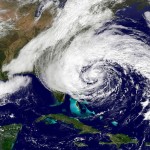
Hurricane Season
For more information » click here
Hurricane season runs from June 1 through November 30
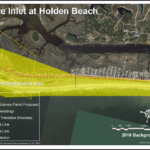
Inlet Hazard Areas
For more information » click here
.
Lockwood Folly Inlet
For more information » click here.

Seismic Testing / Offshore Drilling
For more information » click here.
Biden makes protections from offshore drilling permanent
President Joe Biden has permanently closed off much of the nation’s coasts from prospective offshore drilling for oil and natural gas. The move, announced Monday as Biden wraps up his presidency, includes more than 330 million acres of the Atlantic outer continental shelf, from Canada to the southern tip of Florida, and the eastern Gulf of Mexico, as well as the West Coast, and the remainder of Alaska’s northern Bering Sea.
Everyone from coastal advocates to typically opposite-of-the-aisle politicians representing North Carolina coastal communities, which have overwhelmingly opposed offshore oil and gas exploration and drilling, lauded the president’s action. Wilmington City Councilman and Republican Charlie Rivenbark introduced a resolution opposing seismic airgun testing and offshore drilling off the North Carolina coast to fellow board members nearly 10 years ago. The board unanimously adopted the resolution, aligning the Port City with dozens of other North Carolina municipalities and counties opposed to then-President Barack Obama’s administration’s plan to open waters off the Southeast coast to oil exploration. “I would still be opposed to offshore drilling anywhere, particularly along the North Carolina, South Carolina, Virginia coasts, and I’m glad President Biden’s doing this on his way out,” Rivenbark said Monday morning. “This to me is almost a nonpartisan issue. I grew up on the coast. I know the other side has got terrific arguments and reasons why, but I just can’t take a chance at an oil spill.” That sentiment has resonated throughout not only coastal North Carolina, but also across the state over the course of the last several years. Concerns about the potential for oil spills were specifically cited in the North Carolina Coastal Resources Commission’s April 2019 resolution that opposes offshore drilling. The resolution, which was adopted unanimously, pointed to impacts from the Exxon Valdez oil spill in 1989, the 2010 Deepwater Horizon oil spill and several scientific studies that raise concerns about seismic testing on marine mammals and fisheries. “Seismic surveys and offshore drilling are just not compatible with our coast,” North Carolina Coastal Federation Executive Director Braxton Davis said in an email response to Coastal Review Monday. The Coastal Federation publishes Coastal Review. “Keeping our coast healthy, thriving and free of oil spills is crucial for the survival and prosperity of our communities and is at the heart of our work at the Federation,” Davis said. “For decades now, North Carolina’s opposition to offshore oil and gas has been largely bipartisan. Even under ideal conditions, drilling operations release a number of dangerous pollutants into the ocean, not to mention the potential for larger spills that can devastate local tourism and fisheries.” Governors of both Atlantic and Pacific coastal states pushed back on President-elect Donald Trump’s plan to expand offshore drilling during his first tenure in the White House. In fall 2020, Trump announced he was withdrawing federal waters off the Atlantic Coast from Virginia to Florida from the possibility of drilling for oil and gas. The 10-year moratorium he established ends in 2032. Michelle Bivins, Oceana’s Carolinas Field Campaigns representative, said Monday afternoon that Biden’s announcement “essentially codifies those protections and makes them permanent.” “As for Trump reversing this policy once he’s in office, during his last presidency he protected the South Atlantic from the threat of offshore drilling for almost 10 years, following bipartisan support. He knows that coastal economies and businesses depend on healthy, oil-free oceans,” she said. Shortly after the White House announced the ban Monday morning, the American Petroleum Institute, or API, released a statement calling for the reversal of Biden’s withdrawal the offshore areas from future oil and natural gas leasing. “American voters sent a clear message in support of domestic energy development, and yet the current administration is using its final days in office to cement a record of doing everything possible to restrict it,” API President and CEO Mike Sommers stated in a release. “Congress and the incoming administration should fully leverage the nation’s vast offshore resources as a critical source of affordable energy, government revenue and stability around the world. We urge policymakers to use every tool at their disposal to reverse this politically motivated decision and restore a pro-American energy approach to federal leasing.” Two separate but similar letters – one signed by members of the U.S. Senate, the other signed by House representatives – calling late last year for Biden to implement the ban pointed out that presidential withdrawals had not been successfully challenged in court. Trump in 2017 reversed Obama’s Arctic and Atlantic withdrawals. A district court judge in Alaska ruled presidents do not have authority under the law, in this case the Outer Continental Shelf Lands Act, to revoke prior withdrawals. “A large-scale withdrawal of the Atlantic, Pacific, and Eastern Gulf from fossil fuel development while maintain the development of renewable energy solutions would provide durable protections for these critical areas,” according to the Dec. 19, 2024, letter signed by nine U.S. senators. The areas included in the withdrawal encompass more than 625 million acres, the largest in the country’s history, according to the U.S. Department of Interior. “President Biden’s actions today are part of our work across this Administration to make bold and enduring changes that recognize the impact of oil and gas drilling on our nation’s coastlines,” Interior Secretary Deb Haaland said in a release. “Today, the President is taking action that reflects what states, Tribes and local communities have shared with us – a strong and overwhelming need to support resilient oceans and coastlines by protecting them from unnecessary oil and gas development.” The withdrawals do not affect rights under existing leases, of which there are about 30 off the southern California coast and about a dozen in the Eastern Gulf of Mexico, according to the release. In fiscal 2023, production in the outer continental shelf resulted in about 675 million barrels of oil and 796 billion cubic feet of gas. Almost all of that production is in the western and central Gulf of Mexico, “where industry has yet to produce on more than 80 percent of the 12 million acres already under lease,” according to the release. The current leasing program that runs through 2029 includes three potential lease sales in the Gulf of Mexico planning areas. Those areas are not included in the withdrawal.
Read more » click here

What Biden’s big ban on offshore oil and gas drilling means for NC and the East Coast
The president permanently placed off limits significant portions of the country’s outer continental shelf from future drilling activity. The move represents the largest withdrawal in U.S. history.
In one of his most far-reaching and last moves as the country’s top official, President Joe Biden earlier this month announced he was using his presidential authority to permanently withdraw most unleased areas in federal waters to future offshore oil and gas drilling. The move, which covers the East Coast, West Coast, Alaska and the eastern part of the Gulf of Mexico, was hailed by environmentalists and clean energy advocates as a pro-active measure that sets the U.S. firmly on the path of a decarbonized energy future. But the fossil fuel industry and many Republicans, including President-elect Donald Trump, have railed against the move, calling the blanket ban too much and potentially seriously damaging the push toward making the country energy independent. But while the presidential ban generated plenty of headlines and polished Biden’s environmental credentials, what does it really mean for states like North Carolina that have little to no existing offshore oil or gas industry or infrastructure to speak of?
What exactly did Biden do?
Using his authority under the Outer Continental Shelf Lands Act, Biden withdrew significant portions of the country’s outer continental shelf from future oil and natural gas leasing. The withdrawal areas, which are in waters that extend up to 200 miles from the U.S. coastline, encompass more than 625 million acres, more than 330 million of those in the Atlantic, and represent the largest withdrawal in U.S. history. According to the U.S. Department of the Interior, oil production in 2024 on federal lands and water is at an all-time high. In fiscal year 2023, the outer continental shelf produced approximately 675 million barrels of oil and 796 billion cubic feet of gas, accounting for roughly 14 percent of all oil production and 2 percent of natural gas production in the U.S. Nearly all of this production is in the western and central Gulf of Mexico, where industry has yet to produce on more than 80 percent of the 12 million acres already under lease, the department noted. Most of the Gulf of Mexico isn’t included in the president’s drilling moratorium.
What drilling activity takes place in areas that are part of the new ban?
In short, not much. According to the federal government, there is no active oil and gas exploration and development along the U.S. East Coast or in much of Alaska. There are approximately 30 decades-old existing offshore leases off southern California, and approximately a dozen in the eastern Gulf of Mexico. “Nothing in the withdrawals affects rights under existing leases,” stated a release from the Interior department.
So, is this a big deal?
Yes and no. From a practical point of view, the impact is likely to be minimal. Take North Carolina, for example. The Tar Heel State is not believed to have enough hydrocarbon resources in the waters off its coast to make drilling a viable economic endeavor for the oil and gas industry. It’s been decades since any serious survey work has been done, and even with new advanced ways of extracting fossil fuels from the ocean bottom the uncertainty over just how much of the resource is out there − especially when considering the expense of finding out − likely isn’t an attractive proposition for industry.
On top of that, North Carolina doesn’t have the onshore infrastructure to support any serious offshore development of an oil and gas industry and then get any fuels that are brought to land from the coast to more built-up areas inland. That could mean any economic benefit from drilling off the N.C. coast, aside from some royalties to sweeten any concerns state politicians might have, would be enjoyed by the larger and more developed ports of Norfolk, Virginia, to the north and Charleston, S.C., to the south.
What about the optics of the ban?
North Carolina coastal officials of all stripes have been against offshore drilling for decades. That opposition only heightened 15 years ago after the Deepwater Horizon disaster in the Gulf of Mexico soiled beaches and wetlands in several Gulf Coast states with oil, damaging the environment, killing birds and marine life, and leaving coastal communities reliant on tourism on economic life support. Wilmington and many other coastal communities have passed resolutions opposing offshore drilling, and the N.C. Coastal Resources Commission − which manages development and policies in the state’s 20 coastal counties − also has come out against the practice. Elected statewide officials from both parties in Raleigh and Washington also have pushed back against efforts to open East Coast waters to drilling, both by President Barack Obama and more recently Trump during his first term. That opposition, along with a push for votes, prompted Trump in fall 2020 to announce he was removing federal waters from Virginia to Florida from the possibility of drilling, a ban that was set to expire in 2032.
Can Republicans reverse Biden’s ban?
The fossil fuel industry has come out aggressively against the new moratorium. “American voters sent a clear message in support of domestic energy development, and yet the current administration is using its final days in office to cement a record of doing everything possible to restrict it,” said Mike Sommers, president of the American Petroleum Institute, in a release. “Congress and the incoming administration should fully leverage the nation’s vast offshore resources as a critical source of affordable energy, government revenue and stability around the world. We urge policymakers to use every tool at their disposal to reverse this politically motivated decision and restore a pro-American energy approach to federal leasing.” But the courts historically have said only Congress can reverse a presidential declaration adopted under the Outer Continental Shelf Lands Act, a move that could prove tricky considering how divided and gridlocked Capitol Hill remains. One thing Trump could do, however, and on the campaign trail threatened to do so immediately after taking office, is torpedo a different kind of offshore energy development − wind farms. Steps the incoming administration could take to hamper development of the renewable energy source, long a favorite of Biden and environmentalists worried about the impacts of climate change, is to slow the issue of regulatory permits or opening new lease sites for projects in federal waters and strip wind projects of federal tax credits and other incentives. That could make many of the projects, already costly and facing opposition from some coastal politicians and residents, financially unviable.
Read more » click here

Offshore Wind Farms
For more information » click here
Ports, suppliers in 40 states are invested in offshore wind
The nation’s burgeoning offshore wind energy industry has created thousands of jobs, boosted work in shipyards and ports, and includes a supply chain that spans 40 states, according to a new report. Billions of dollars have been invested in things like new and retrofitted vessels for offshore wind developers, ports infrastructure, and the expansion of renewable energy manufacturing facilities that support offshore wind, according to Oceantic Network, a Baltimore-based nonprofit that advocates growing the country’s offshore renewable energy industry and supply chain. According to the report, “Offshore Energy at Work,” 25 U.S. ports are either taking part in the industry or preparing to support it. Last February, North Carolina State Ports Authority Executive Director Brian Clark signed a record of decision on a proposed plan to create a multi-use terminal that would support manufacturing and operations for offshore wind and automotive industries at the Morehead City port. The proposed project entails developing land the port owns on Radio Island. It includes construction of a 300,000-square-foot manufacturing facility with office space for offshore wind, a roughly 60-acre gravel pad for storage, a new rail spur that would tie into the existing rail, roadway improvements, and the installation of a gas line from Morehead City to the island. The estimated price tag is $250 million to $285 million. “We have no updates to provide at this time,” Elly Cosgrove, N.C. Ports senior communications manager, said in an email Wednesday. “The Record of Decision signed in February is the latest as it pertains to Radio Island.” It is unclear how an executive order President Donald Trump signed in his first day back in the White House pumping the brakes on new offshore wind development might affect the ports’ proposed plans, including four lease areas off the North Carolina coast. Five days after Oceantic Network released its 60-page report, Trump suspended new leases on the entire outer continental shelf. The order will stand until it is revoked. The order also blocks the federal government from issuing new federal permits to offshore and onshore wind projects, including four lease areas off the North Carolina coast, until the secretary of Interior conducts a “comprehensive assessment and review” of the permitting process. Oceantic Network joined other renewable energy proponents in immediately rebuking the president’s order, calling the permitting pause “a blow to the American offshore wind industry.” Trump’s actions threaten thousands of American offshore wind industry-related jobs in shipyards, factories, and ports, and “strand businesses who have reorganized their operations to support the sector,” Oceantic said in a release. “While under a National Energy Emergency created by an unprecedented rise in energy demand, we should be working to quickly bring generation online instead of curtailing a power source capable of providing base load generation and creating new jobs across 40 states,” Oceantic founder and CEO Liz Burdock said in the release. “We urge the administration to reverse this sweeping action and keep America working in offshore energy as part of its commitment to an ‘all-of-the-above’ energy strategy.” A spokesperson for Oceantic Network declined to comment further. In a statement it released following Trump’s order, the Southeastern Wind Coalition called offshore wind “an economic force” in the U.S., investing billions of dollars in reviving previously underutilized ports and creating training programs for the work sector. “Wind energy is critical to achieving American energy dominance, meeting our growing electricity demand, and creating stable manufacturing jobs across the nation,” Southeastern Wind Coalition President Katharine Kollins said in a release. “Wind energy is a vital part of the global electricity system, and ceding the advancement and development of wind technologies to other nations will only set us back.” More than 100 companies in the Southeast produce components for the industry, according to the wind coalition. But at least one of those has turned to the European market to stay afloat. An official with Nexans, a France-based power and communications cable producer, said in an article published earlier this month that the company’s Charleston, South Carolina, plant — the largest subsea cable manufacturer in the U.S. — is shipping its product to Europe. Nexans vice president for generation and transmission told renewable energy publication Recharge that high demand for cables in Europe is “a blessing in disguise” for the plant. Still, all is not all doom-and-gloom for the industry. In an email announcing the dates and location for the International Partnering Forum, the largest offshore wind energy conference in the U.S., Burdock noted that five commercial-scale, federally approved offshore projects are either under or near construction. Another six projects have received federal approvals. “Despite misleading headlines, there is no question that the industry is moving forward,” Burdock wrote.
Read more » click here
As NC wind energy projects advance, uncertainty rules
Wind projects that are leased, permitted or under construction in or near North Carolina are likely to survive buffeting by renewed wind energy skepticism from the Trump administration. Shortly after taking office in January, President Donald Trump issued an executive order barring new offshore wind leases and requiring reviews of existing and permitted wind projects. Although it was not targeting existing leases, industry supporters have questions about what rules, permits or projects it could impact and the potential for broader impacts through the workforce and manufacturing industries. “It’s not that companies are moving on as business as usual, but there’s so much uncertainty that they can’t just come to a screeching halt, and then all of this could change in five minutes,” Karly Lohan, Southeastern Wind Coalition’s senior Carolinas program manager, recently said in an interview with Coastal Review. “They have to keep going and figure this out as they go. And realistically, we’re probably not going to know an answer to a lot of those questions, and the true implications of this offshore wind executive action until … we know.” Lohan noted that the nonprofit coalition she represents is focused on educational outreach about wind energy and does not speak or act as a trade organization for the industry. A wind project off Kitty Hawk along the Outer Banks that’s owned by Avangrid Renewables and Dominion Energy is not yet under construction, but it still has active leases. Dominion Energy’s $9.8 billion Coastal Virginia Offshore Wind, or CVOW, project off Virginia Beach is going full speed ahead. The 2.6-gigawatt project is currently about half done and is expected to be completed on schedule by the end of 2026, according to company spokesman Jeremy Slayton. Duke Energy, along with Total Energies, has leased an offshore area off Southport for a wind farm known as Carolina Long Bay project, but it is in very early permitting stages. “We are still easily at least six or seven years away from construction for any of those projects,” Lohan said. The two land-based wind energy projects in North Carolina — Amazon Wind U.S. East in Elizabeth City, completed in 2017, and Timbermill Wind in Chowan County, completed in 2024 — will not be affected by the orders, Lohan said. Duke Energy has expressed interest in future land-based projects in North Carolina, but no information has been released about potential locations or plans, she said. While Dominion is working to complete its Virginia Beach project, it is keeping its CVOW-South, formerly the Kitty Hawk North project, on hold for the time being, Slayton, the company’s spokesman, said. “CVOW-South provides us with a potential option for additional offshore wind development,” he said in an email. “Our most recent long-term planning document, the Integrated Resource Plan, forecasts this project, if we pursue it, for the mid-2030s. At this time, we do not have a firm timeline or cost for developing this lease area.” Dominion Energy came to an agreement in July 2024 to purchase one-third of the Kitty Hawk North project, which is about 27 miles east of Corolla, the northern end of the Outer Banks, and about 38 miles southeast of the Sandbridge community in Virginia Beach. “Avangrid was willing to sell a portion of the project at a reasonable cost,” Slayton told Coastal Review at the time. “And we believe it was prudent to take advantage of this opportunity to meet the growing needs of our customers with clean energy and also help us achieve the requirements of the Virginia clean Economy Act, which calls for up to 5.2 gigawatts of offshore wind.” If developed, the project will connect to the grid for CVOW-South at a new substation at Corporate Landing in Virginia Beach, near Naval Air Station Oceana, he said. Katharine Kollins, president of Southeastern Wind Coalition, a nonprofit advocacy group, said that wind power production in the U.S. is behind the mature development of both offshore and onshore wind in Europe, but it has the capacity and resources to build a robust wind energy industry. “It requires economies of scale in manufacturing, all of the components it requires, economies of scale in construction and development and even in operations and maintenance,” she told Coastal Review recently. “And so, what the manufacturers have been saying to advocates in the industry for years is, ‘We need a solid pipeline of projects before we can commit a billion dollars to building a manufacturing facility in the U.S. that can then produce the major components, or an offshore wind turbine that would include your towers, your blades.’ Right now, I think the only thing that we can manufacture in the U.S. is foundations.” Like any energy production, wind energy is an equation of risk versus benefits, she said. And wind is economical, clean and safe, she added. “You don’t hear anything about wind spills,” she said. Yes, there are bird mortalities associated with strikes, but far, far less than the estimated one billion annual deaths from birds striking buildings. Kollins said the problem is uncertainty. “You know, uncertainty is not good for investment, and so if you have some significant political uncertainty, which makes it really hard for investors to move forward with any of those components that I was mentioning, whether in components, referencing manufacturing, referencing development, even thinking about leases. “Like, am I going to go pay $100 million to lease a square of ocean that, then I might have another presidential administration that says, ‘I don’t really like this?’ No thanks,” she said. “It does make it hard to overcome. This is an industry that should be nonpartisan.”
Read more » click here
Things I Think I Think –
 Eating out is one of the great little joys of life.
Eating out is one of the great little joys of life.
Restaurant Review:
The Dinner Club visits a new restaurant once a month. Ratings reflect the reviewer’s reaction to food, ambience and service, with price taken into consideration.
/////
Name: Caprice Bistro
Cuisine: French
Location: 10 Market Street, Wilmington NC (downtown)
Contact: 910.815.0810 / https://www.capricebistro.com
Food: Average / Very Good / Excellent / Exceptional
Service: Efficient / Proficient / Professional / Expert
Ambience: Drab / Plain / Distinct / Elegant
Cost: $25 Inexpensive <=20 / Moderate <=26 / Expensive <=35 / Exorbitant <=60
Rating: Four Stars
Caprice Bistro looks every bit like a real authentic French bistro. A bistro is a small restaurant serving moderately priced simple meals in a modest setting. The menu has a great traditional bistro selection of authentic French & Belgian cuisine prepared home-style. The atmosphere is welcoming, warm and inviting. The art-filled upstairs sofa lounge and bar area is great. This is a personal favorite of mine because of the consistent delivery of a fine dining experience every time that we go there. Certainly, it is among the best restaurants in town; you really should put it on your short-list of must try restaurants.
Caprice Bistro has new owners
With its classic French fare, this downtown Wilmington restaurant is a perennial favorite. The owners have sold the business to well-known local entrepreneurs. Thierry and Patricia Moity opened Caprice Bistro on Market Street in 2001. Now the couple, who were at the restaurant most every day running the front of the house and the kitchen, have decided it is time to pass the business on to new owners. The new owners will add their own touch to Caprice, but they plan to continue the menu, the tradition and the service.
Dining Guide – Local * Lou’s Views
Dining Guide – North * Lou’s Views
Dining Guide – South * Lou’s Views
Restaurant Reviews – North * Lou’s Views
Restaurant Reviews – South * Lou’s Views
Book Review:
Read several books from The New York Times best sellers fiction list monthly
Selection represents this month’s pick of the litter

HERE ONE MOMENT by Liane Moriarty
On a domestic flight that’s delayed on the tarmac, a mysterious woman walks up the aisle, points at a fellow passenger, and pronounces ‘I expect’ followed by an age at death and a cause of death for several of the people on the plane. There are a few storylines going on in this book which follows the lives of each of the doomed passengers and their reactions to these predictions, questioning how knowledge of one’s fate can alter their behavior.
That’s it for this newsletter
See you next month
Lou’s Views . HBPOIN
. • Gather and disseminate information
. • Identify the issues and determine how they affect you
. • Act as a watchdog
. • Grass roots monthly newsletter since 2008

